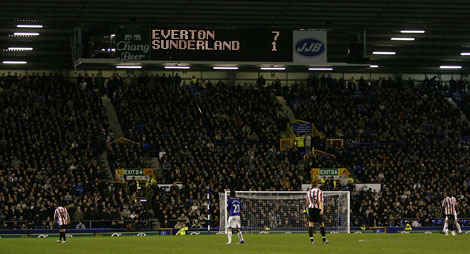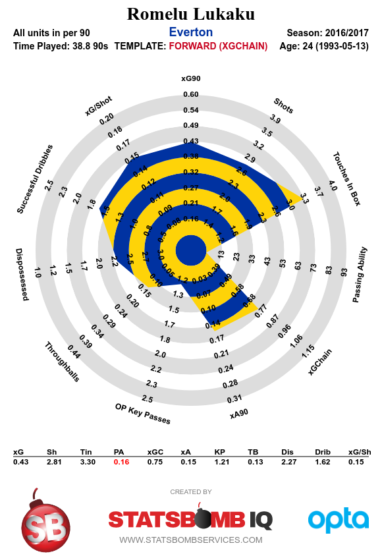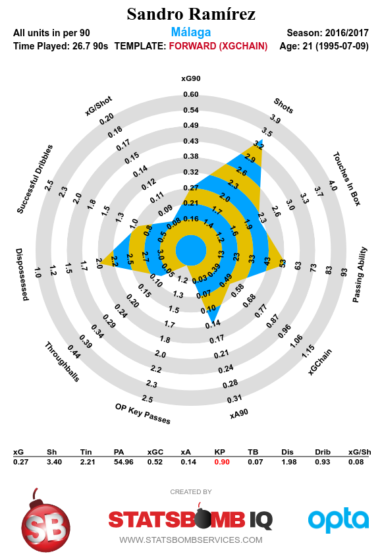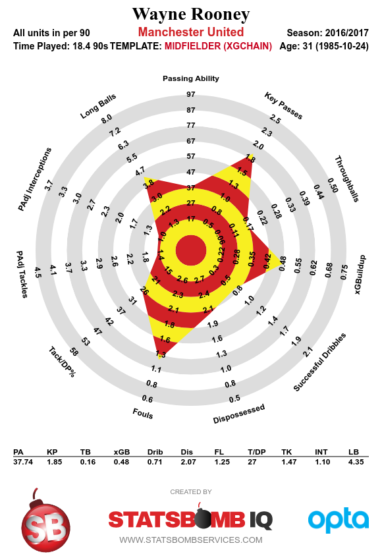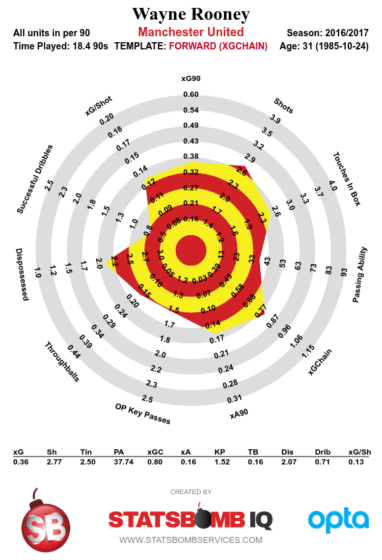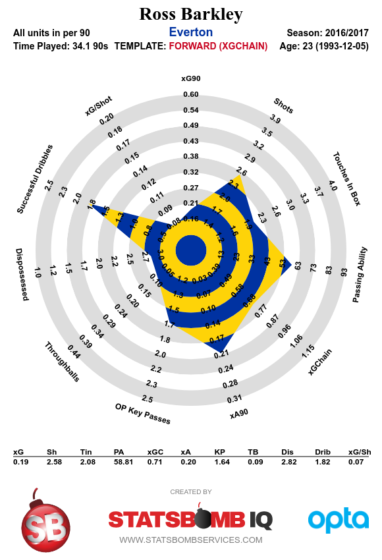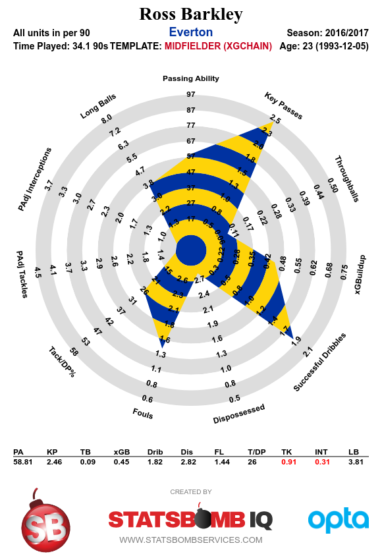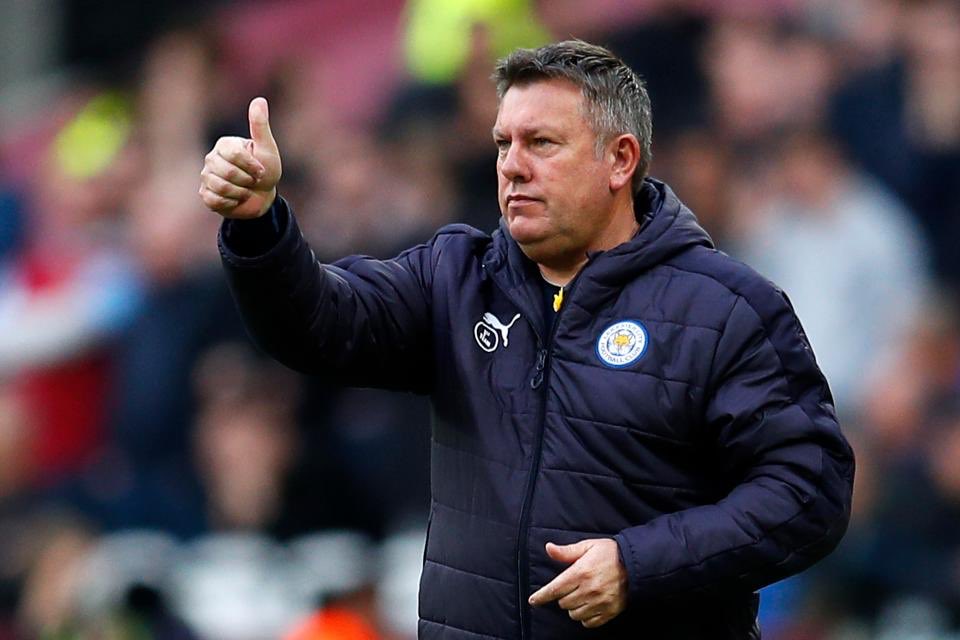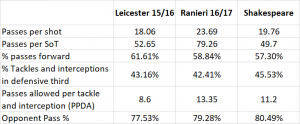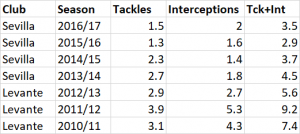Seventh
MISSION ACCOMPLISHED! The 2016/17 Best-of-The-Rest Cup has returned to its rightful home in the Goodison trophy cabinet. Tarnished somewhat by having been downgraded from 5th to 7th place, it's still a trophy, and we shouldn't begrudge Ronald Koeman providing an immediate return on his £7m-a-year salary. From around February we are better than evens to finish 7th, no higher, no lower, and never faced a real challenge to our septpremacy from Southampton under-performing in front of goal, nor from Bournemouth getting their first taste of England's top 10, nor even from West Brom, returning to the top half of the table for the first time since saying goodbye to one Romelu Lukaku (of whom more later, duh).
We also made progress on the stadium front, securing land at Bramley Moore Dock. I say 'land', obviously right now it's all underwater. In fact, I say 'securing', obviously we haven't raised the money to pay for any of it yet. But you wouldn't bet against our cadre of Russian money men, would you? Mayor Joe Anderson's inbox is probably already brimming with offers of dirt on his opponents for the 2020 elections.
We started the season with Lukaku still recuperating from that awkward holiday we've all had where your ex turns up to the same resort. Sources from within Belgium's Chateau du Haillan training camp claim that Lukaku and Robert Martinez could be heard attempting to stoke each other's jealousy well into the small hours of the morning, the former loudly praising Thierry Henry's tactical prowess, the latter bouncing on the bed complimenting Michi Batshuayi's finishing skill.
This meant that we started the season with a 3-4-3, the honed spearhead of Mirallas, Deulofeu and Barkley up top, James McCarthy on the right against Tottenham. In the first half, we took no shots after the 19th minute. In the second, we took none after the 79th. We won a point off a fluky Barkley free kick that found its way through to the far post. The 3-4-3 persisted against West Brom where we overturned an early set-piece goal to win 1-2. With Lukaku back in the team, and £25m man Yannick Bolasie a regular fixture, we mostly fielded a 4-2-3-1 with Barry and Gueye holding, Bolasie, Barkley and Mirallas ahead, or a 4-3-3 with Barry deepest and Gueye and Barkley in the headless chicken roles in the middle, Mirallas and Bolasie flanking Lukaku. The 3-4-3 returned against Chelsea in early November. Antonio Conte had laughed off suggestions he was facing the sack in late September, and by the time Everton made their visit to Stamford Bridge he was already 4 wins into the 13-game winning streak that would all but secure them the title. We took a single shot that day, and Conte would continue laughing for quite some time afterward.
At the half-way point of the season, the top 6 were already 9 points ahead of 7th, and while Everton had picked up a couple of creditable wins against Arsenal and away to Leicester, and grabbed a point off each Manchester side, it was only really a run of four wins against fairly easy opposition in August and September that was propping the season up. The football wasn't much to look at, we defended a bit better, showed a bit more energy when pressing, but it didn't feel as if we had any plan or systematic advantages in attack. We crossed a bit, and Lukaku found ways to score.
The fundamental issue we seem to have under Koeman is the disconnect between our build up and our attack. There's not a great deal of movement and interplay in the centre, so we're reliant on longer balls (especially out wide) to progress towards the goal. Gareth Barry (offered a new contract at 36, and apparently a target for Tony Pulis) has generally been the only midfielder who reliably can progress the ball in this way. The stat that stands out to me is this: Everton's passes into the final third were the 6th longest on average in the Premier League last season. Only Watford, Burnley, Palace, West Brom and Sunderland relied on longer passes to get the ball forward. I wouldn't mind this - gaining lots of ground quickly is great - but we're bottom half of the table for completing these passes. I haven't seen much in pre-season to show we've addressed these issues: I certainly like Ademola Lookman's movement more than most of our other attackers, and Klaassen has decent first touch, so perhaps we'll see this completion rate go up even if the plan doesn't change.
A minor tactical turning point in our season came in December when Bolasie suffered a long-term knee injury. Deulofeu was unable to replace him, and all that could be done for the poor lamb was to ship him off to Milan to assist more xG per 90 than any player 23-and-under in the big leagues, before forcing him to make a humiliating return to Barcelona. This meant the team, outside the reliable Baines and Coleman, had slightly less width to exploit. Morgan Schneiderlin arrived in January, by which time Tom Davies had broken into the team looking like a Viking chieftan's daughter disguised in a fake beard after her father forbade her from joining the raiding party, intent on proving her valour.
This is an entirely aesthetic metric, but you can see the change in our play by looking at the ratio of crosses to through balls. Before the New Year, we took around 27 crosses for every through ball we made, the 6th highest ratio (Arsenal take 4 crosses for every through ball, Swansea and Palace 60+, just for some context). After the New Year, though, we had the 6th lowest ratio: 14 crosses per through ball. In this period we still oscillated between the 4-3-3, 4-2-3-1 and 3-4-3 but I actually quite liked some of our play, harrying opponents' midfielders, occasionally producing nice combinations in the centre, and securing some memorable wins, not least the 4-0 against Man City. What we didn't manage to do was bring that final third entry pass length stat down. Tom Davies added a lot of energy and some penetrative passing to the team, Schneiderlin has some of Barry's long ball game, and finished the season with the highest xGBuildup per 90 of anyone in the team. But without Lukaku's 24 non-penalty goals from ~17xG on the end of all this, I'm unconvinced we systematically create enough danger to really compete at the top level of the EPL.
Let's talk Lukaku: he was better than we deserved when he arrived on loan, and he's been better than we deserved every season since. If he were on a great Everton team, he'd be rivaling Gary Lineker's numbers, but as it is we got to see an Everton player finish with 25 league goals in a season for the first time in more than 30 years. He stayed for promises of Champions League football, gave Koeman a chance, and leaves us with a profit of nearly £50m. His capture was possibly Roberto Martinez's singular achievement, both in convincing the player and the board to make it happen.
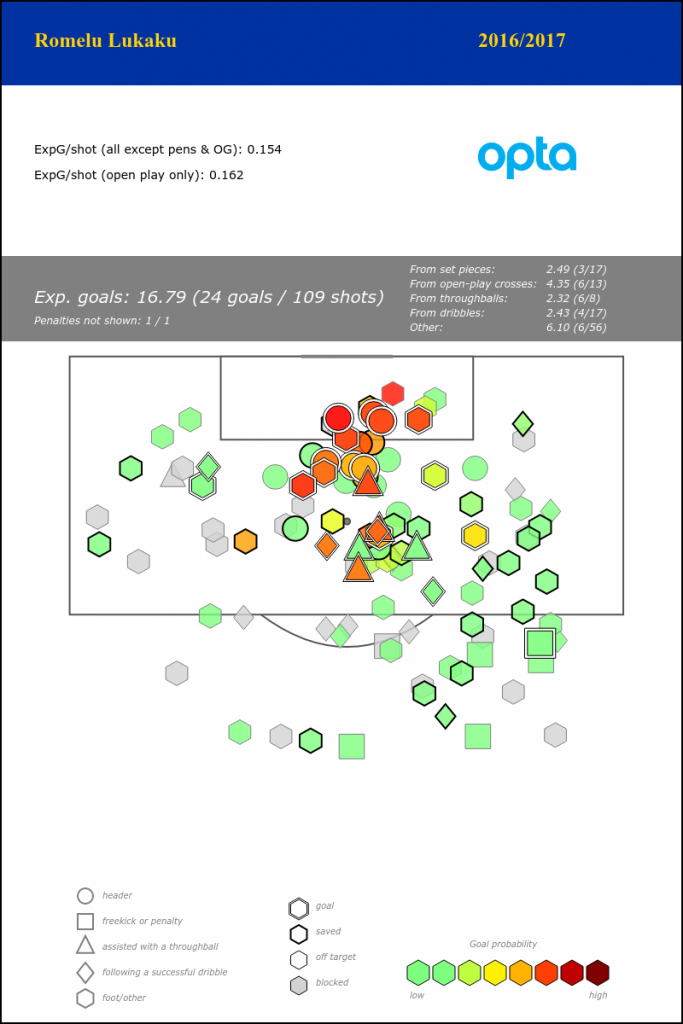
Strikers often struggle with perceptions. I always remember Lukaku's goal against Chelsea in the FA Cup, he points where he wants Barkley to put the ball, makes the run, looks up, looks up again, beats two players, shrugs off a foul, beats another two players with the tiniest of touches, and side-foots it past Courtois inside the far post. The commentators inevitably described him as "like a man-mountain there". It was a lovely goal, and it's true: his strength kept him on his feet despite one defender grabbing his shoulder and trying to haul him down. But I don't think Lukaku gets much credit for his vision and intelligence, and the amount of work he puts into his technical game off the field.
That all plays into the narrative that he's clumsy and has terrible first touch. We can investigate if this perception is actually fair with some simple stats: strikers receive passes in the final third, and we look at whether their next non-shot action is successful or not. So, they get the ball, and maybe pass, or dribble past a defender, whatever. Which strikers have a better or worse success rate with these actions? Looking at the last four seasons and limiting to players that have received a total of more than 500 passes in that time, Lukaku ranks 10th out of 26. He's above Diego Costa, Harry Kane, Alexis Sanchez, Luis Suarez, Olivier Giroud and plenty of others. He ranks worse for the eventual xGChain of those possessions, so perhaps he's not creating a ton of a danger in his hold-up play, but at the same time Everton rely so much on him to be on the end of moves that you'd expect less xG from possessions involving him in the buildup. Either way, I don't think he's as bad as people think, and besides, it's not our problem now. Go with love, Big Rom.
Seventher
Everything turns upon this simple equation:
Position2017 = 7th - Lukaku - European Campaign + The Genius of Steve Walsh
Are we a seventher team than last season? Are we more than seventh? Or without Lukaku's goals, and facing attrition from Europa League games, might we actually find ourselves south of Southampton this year? Our Summer business was ambitious in quantity, if not in quality. But even if we land Gylfi Sigurðsson for the price of 0.25 Neymars, I don't think we've made a single signing in the same league as the outgoing Lukaku (or the top 6's incoming Salah, Morata, Lacazette, Mendy etc etc). Maybe you'd stack our signings up against Tottenham's big pile of nothing, but over 24 months they seem like as good a team as any in the EPL and don't seem to expend any fucks on European competitions.
I haven't accounted for one additional factor in the complex scientific equation above: Charlie Reeves, a data analyst poached from Forest Green Rovers, indicating at the very least that Walshie wanted an up-to-date spreadsheet to start sorting. My only concern is that in this window, the flashing red light attached to his veto button has clearly malfunctioned. If there's budget for a replacement, future windows might make more sense to me.
The biggest story of our Summer is of course the return of always a blue Wayne Rooney. He brings with him such a weight of narrative I don't know where to begin. When he left Everton, we immediately finished in the top 4. Now he's returned, does symmetry demand that we or Man Utd return to the top 4? The boy Rooney ended Arsenal's famous 49 match unbeaten run, could the man put us ahead of Arsenal, and end Wenger's tenure entirely? Storylines aside, Rooney is still a perfectly cromulent Premier League player, but he's more of a replacement for Ross Barkley than Romelu Lukaku. I don't believe that Rooney plus Sandro Ramirez (plus Sheffield lad Dominic Calvert-Lewin) equals anything approaching one Lukaku, but then again I don't really understand what Koeman's hoping for in attack.
Elsewhere, Davy Klaassen joins our midfield, though I'm slightly suspicious of attackers coming from Eredivisie with anything but bonkers stats, which he does not possess. He certainly has tidy feet and quicker passing than we're used to, but I've seen little evidence of enough intelligent movement around him to really take advantage.
Since Neville Southall, it's never felt like Everton have had a truly generational keeper. Nigel Martyn's swan song and Tim Howard's often-unfairly maligned tenure brought some solidity, but could Jordan Pickford be Everton's number 1 in 5 or 10 years? I'll admit I didn't see him much last year, it was hard to watch Moyes's Sunderland, a bit like your dad going through a bad divorce and trying to get all his uni mates back together to for one last year-long binge. But his shot stopping numbers look fine from the small sample we have. As long as he doesn't fall out of his loft or get injured warming up he certainly seems like he has a better shot than most, if only because of the expectations of his price tag.
Michael Keane shaves some necessary years off our defence's average age. He's joining a very different back line to Burnley's, his numbers last year show very little pro-active play in terms of tackles and interceptions, but his aerials and blocks per shot were good. Our passing model quite likes him, and already in pre-season I've seen him sprint 40 yards through the middle of the pitch with the ball so it'll be a wild ride at the very least.
There's also the possibility that Ross Barkley leaves. I genuinely think he's progressed and taken up more responsibility, but there are always the suspicions that the gaps in his game are all things that can't be taught: decision making most of all. I'd always hoped that if we cashed him in, it'd be for John Stones money, but barring a bidding war those days are gone, as his contract winds down and his manager constantly criticises him in the press. If he moves, I hope he's turns out to be more Rooney than Rodwell - he always put in the effort, and came back from some horrible injuries early in his career. Who knows, maybe he'll make a dream return as our number 10 for the 2025/26 season.
Anyway, I've cranked all that through the supercomputer and it reckons... 7th.
Seventhest
So what's the long-term plan? We're behind the rest of the class and we're going to catch up to them by going slower than they are? Are we to sit poised in 7th, waiting for the Mad King Arsene Wenger to self-immolate? Hoping Mourinho and/or Chelsea have another 2015/16, that Pep truly is a fraud, that Pochettino's head is turned by a more generous sugar daddy and his Tottenham project is picked apart, that Raymond Verheijen will jump out with a police baton and assail the knees of the entire Liverpool squad?
We've spent, upped our wage bill, and signed solid players to accommodate Europe. I feel grumpy saying this, but it's all probably fine. It's entirely possible that Koeman's targets from the board do ultimately include the top 4, maybe he even thinks we have a shot this season. Our last mad dash for the Champions League was Martinez's series of loan gambles, and hell, we had a bunch of luck and very nearly got there, before it then immediately fell to pieces. But I see no hope of replicating that in the next couple of years. It wasn't so long ago that you'd interpret any sort of £50m bid as a sign of ambition, but in Premier League terms who knows what it now represents, especially taking into account our new and deeper pockets.
I'm not a huge fan of what's happening on the field, and I don't think we're getting value in the transfer market. But look at the next 5 years as a slow, iterative process: secure 7th, not a bad spot in such a competitive league. Try to become a fixture in the later stages of the Europa League. Between that and the stadium, slowly increase our reputation and make us more attractive to transfer targets and commercial partners. Build out the back office, chuck in a few analytics people. Keep developing and playing the youth, who are already a big part of their respective England setups.
There are worse ways to run a club, and let's face it, we've witnessed most of them in the last 30 years. Nil satis nisi septimum.
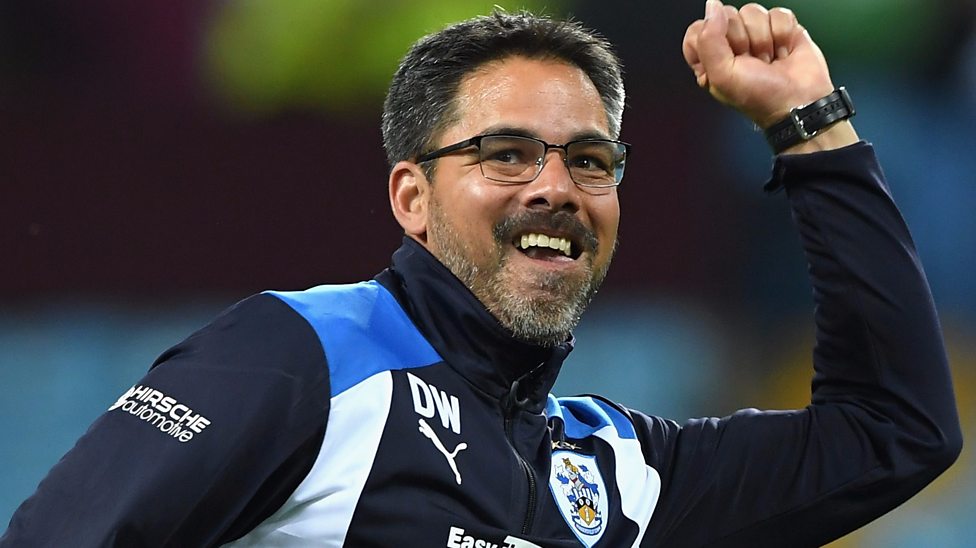
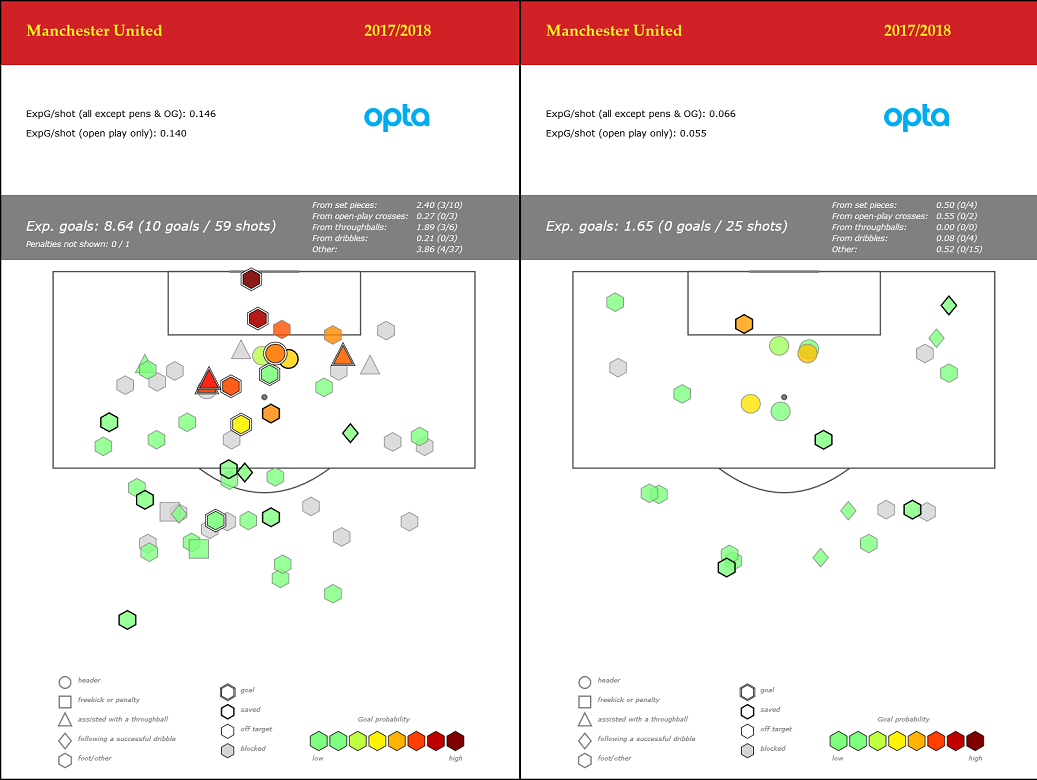
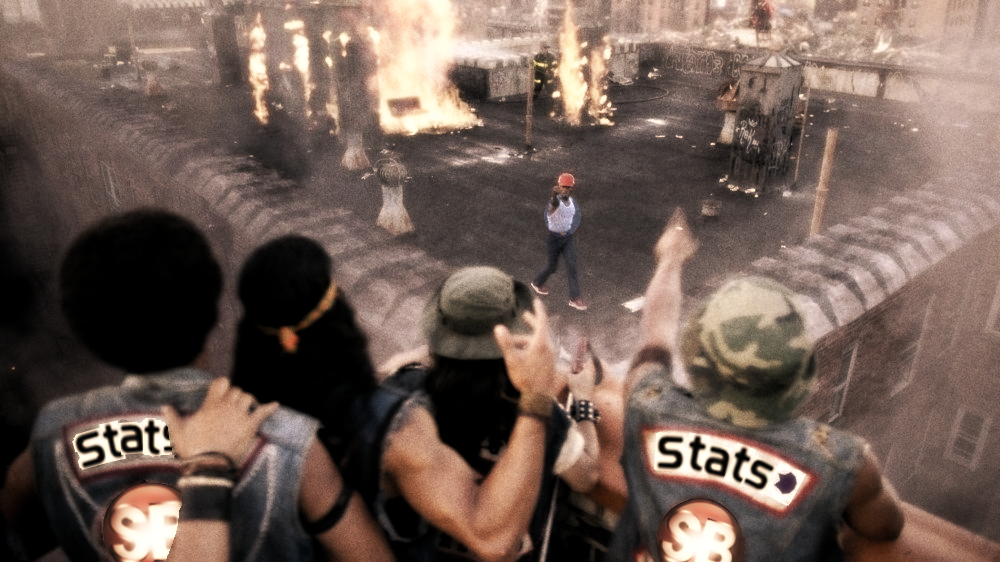
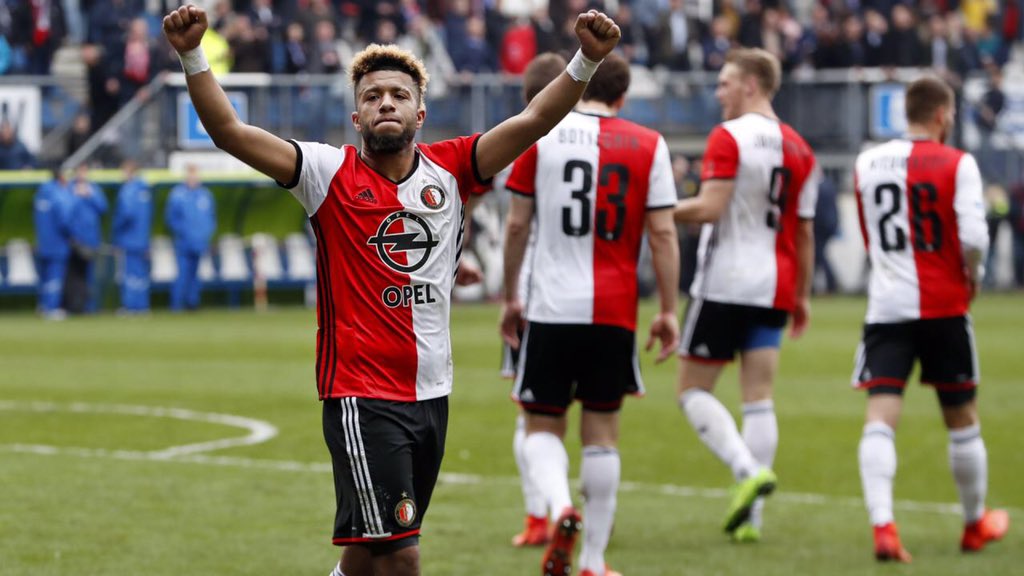
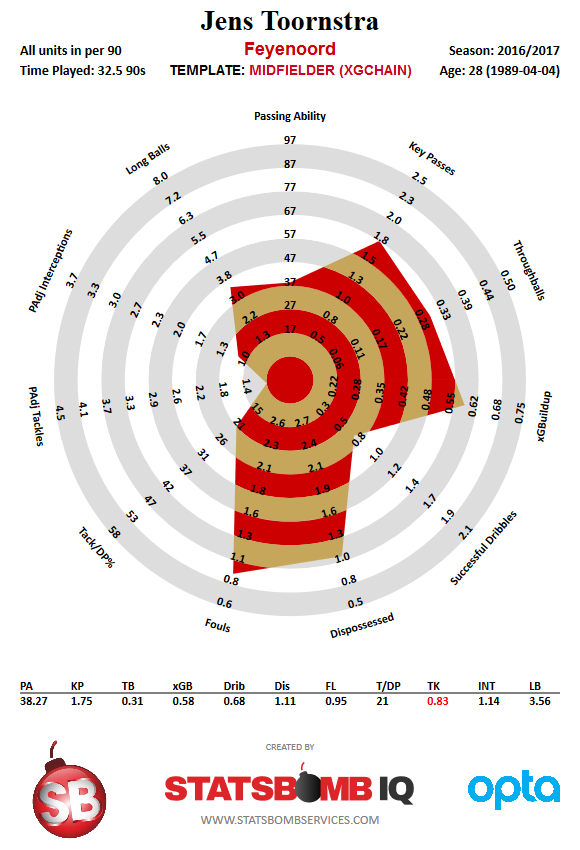
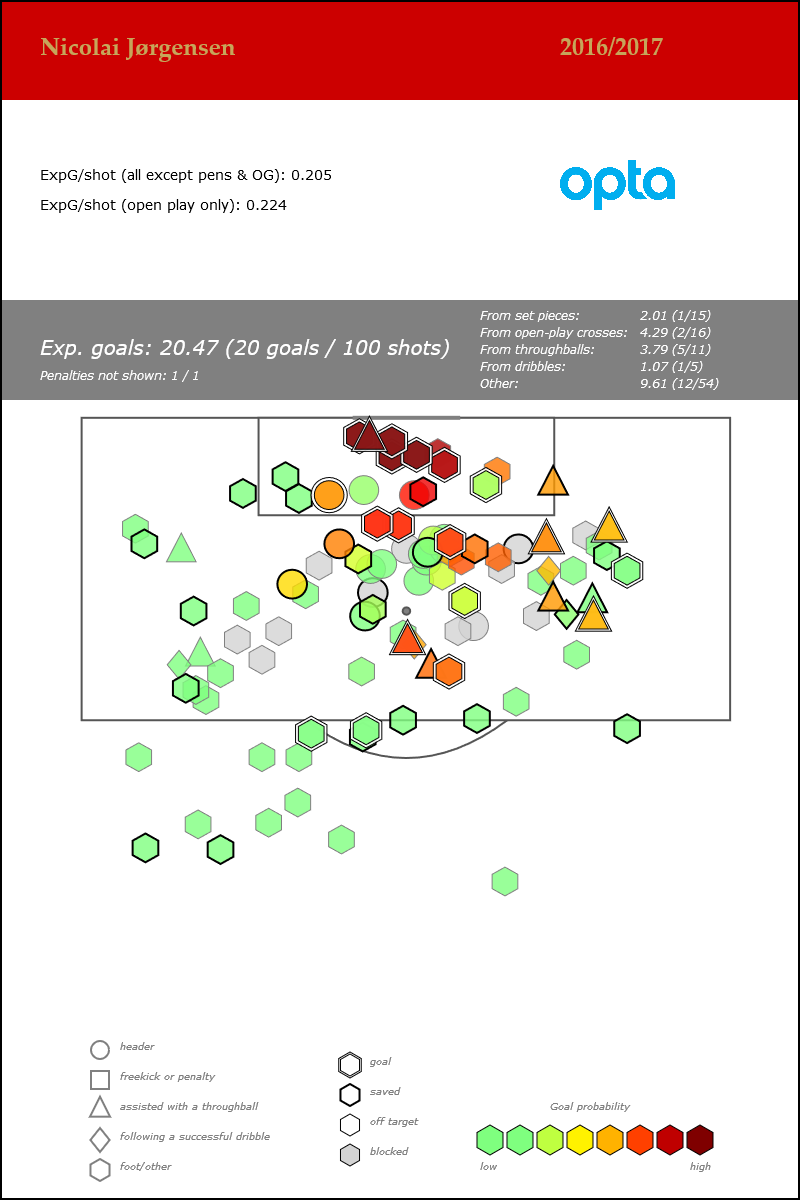
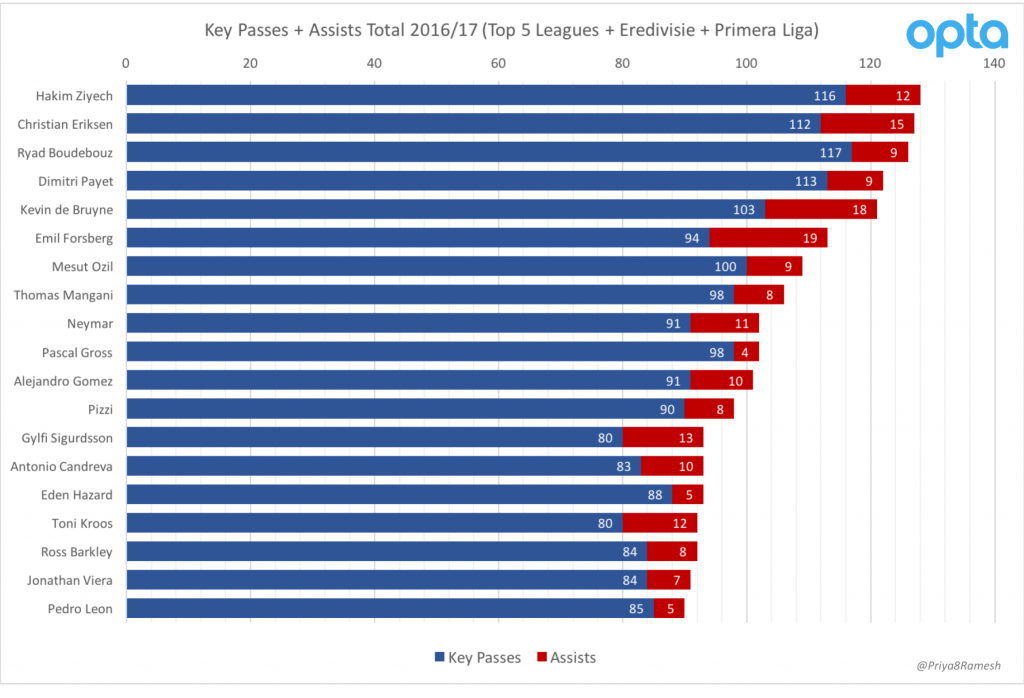
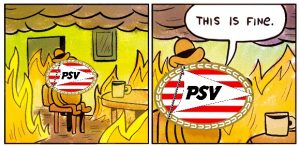 PSV
PSV 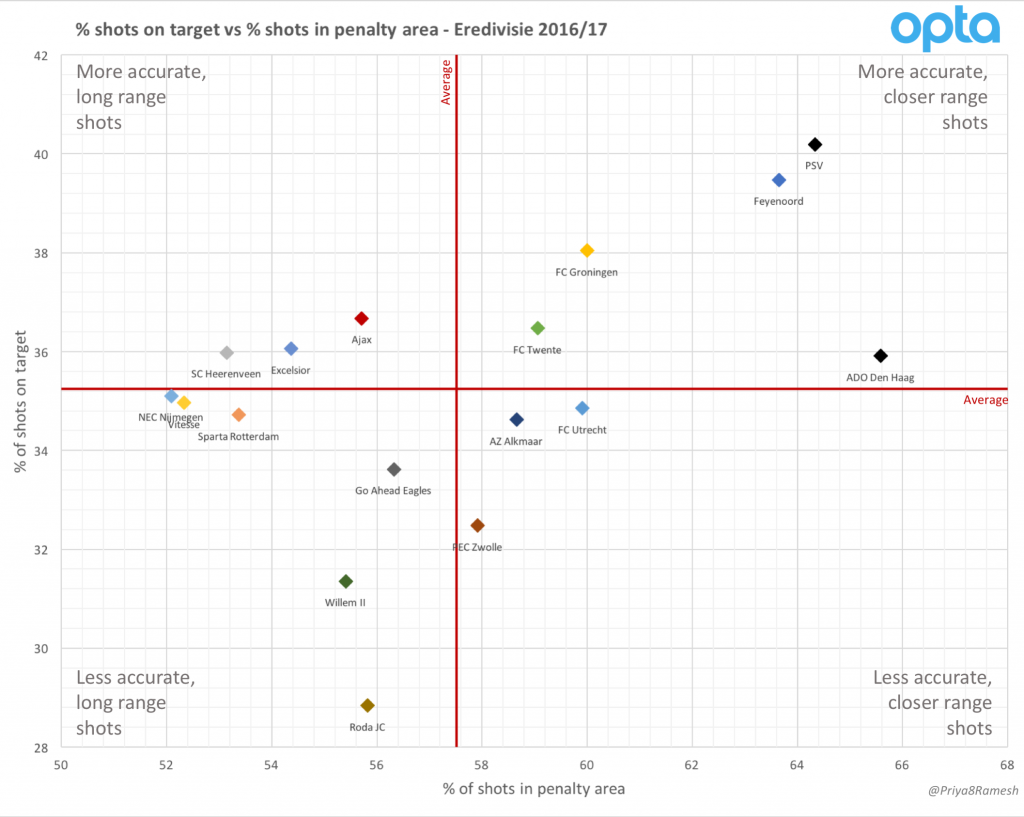
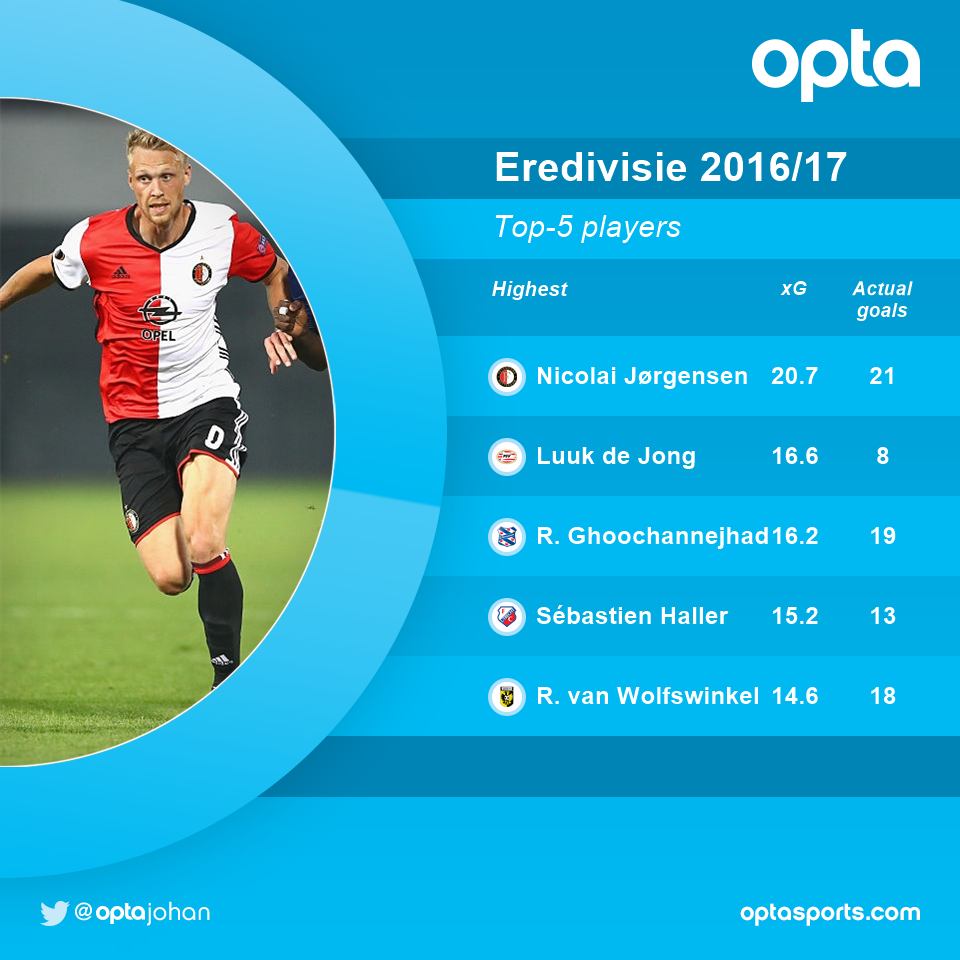
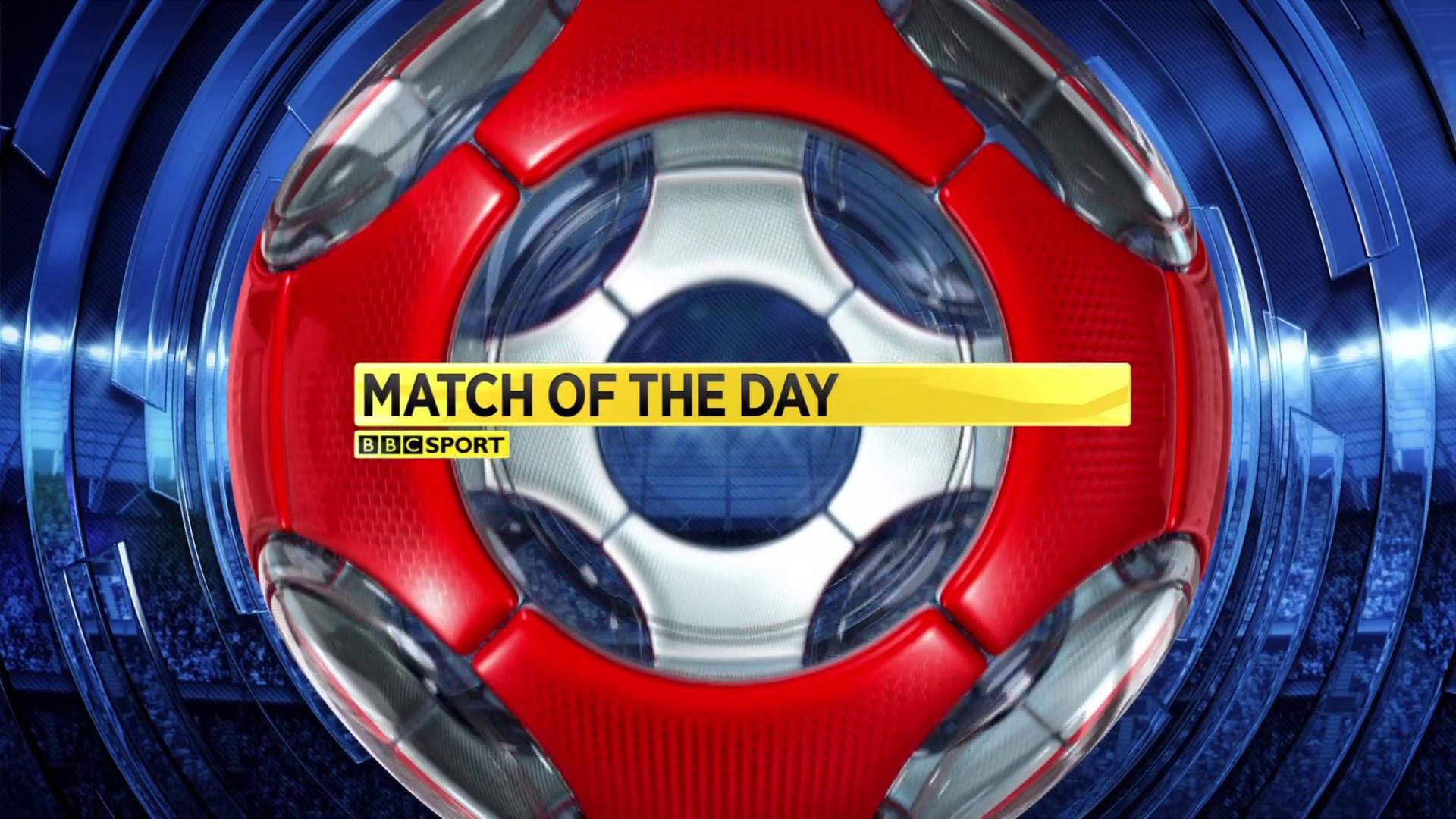
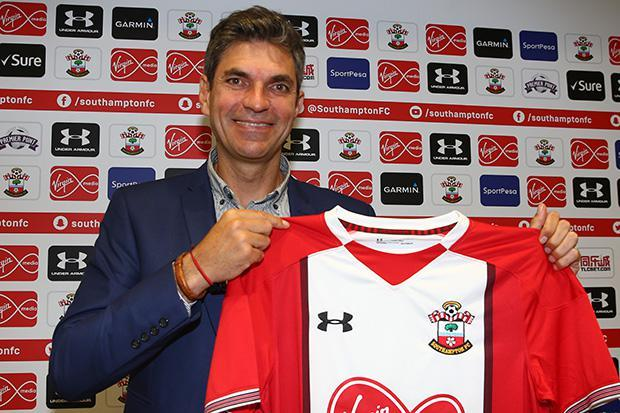
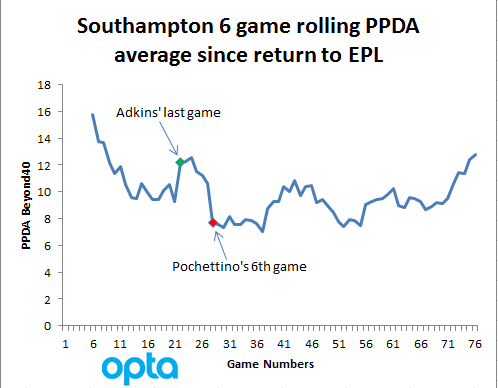 It’s clear that part of the reason he was sacked was because the fans weren’t happy with the lack of fun that involved watching them on a regular basis. I think the complaint itself isn’t unreasonable, whether he should’ve been sacked for that is another question. What is to wonder is whether or not the hierarchy at the club thought that this team would’ve had another season of converting shots at a poor rate under Puel. I'm skeptical of that being the case considering he coached a Nice team in 2015-16 that overachieved because of variance. Southampton got some of the worst luck we've seen from a PL side, but even then it's also fair to suggest that the process the club undertook wasn't without its faults. In his place is Mauricio Pellegrino, a guy whose name is a delightful hybrid between Mauricio Pochettino and Manuel Pellegrini. Fans will be hoping that his managerial chops are of the same category as those two, and his work at Alaves dictates that he might be up to the challenge. With a shoestring budget, he led Alaves to a commendable 9th place finish in La Liga with both goal and expected goal differential mirroring each other.
It’s clear that part of the reason he was sacked was because the fans weren’t happy with the lack of fun that involved watching them on a regular basis. I think the complaint itself isn’t unreasonable, whether he should’ve been sacked for that is another question. What is to wonder is whether or not the hierarchy at the club thought that this team would’ve had another season of converting shots at a poor rate under Puel. I'm skeptical of that being the case considering he coached a Nice team in 2015-16 that overachieved because of variance. Southampton got some of the worst luck we've seen from a PL side, but even then it's also fair to suggest that the process the club undertook wasn't without its faults. In his place is Mauricio Pellegrino, a guy whose name is a delightful hybrid between Mauricio Pochettino and Manuel Pellegrini. Fans will be hoping that his managerial chops are of the same category as those two, and his work at Alaves dictates that he might be up to the challenge. With a shoestring budget, he led Alaves to a commendable 9th place finish in La Liga with both goal and expected goal differential mirroring each other. 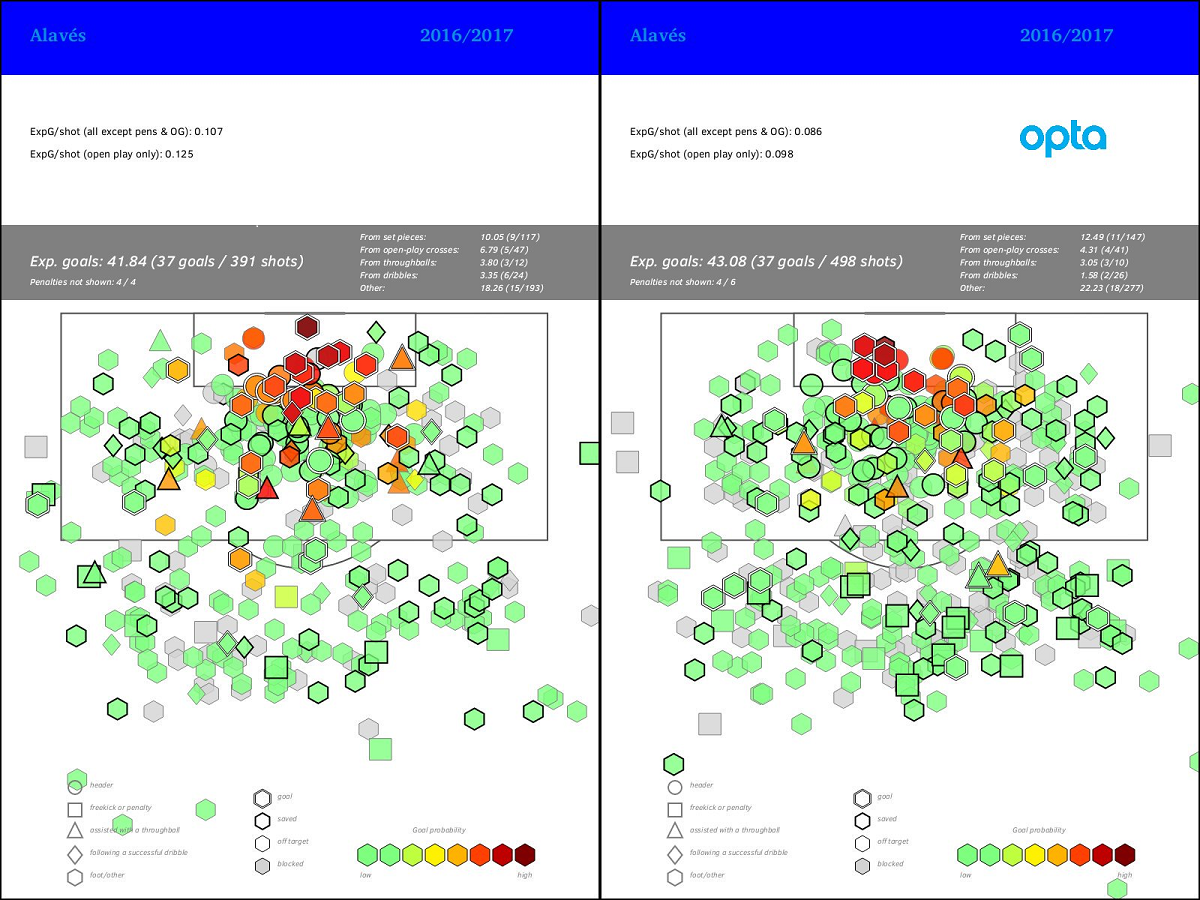 What's intriguing here is the difference in shot quality in both directions. Southampton focused more so on beating the opposition by volume, while Alaves focused on shooting from the central zones and forcing opponents to take low quality opportunities. It's fair to wonder whether Pellegrino could merge the two worlds in a way that Puel never really came close to doing. The attack will be doing it with basically the same squad as last season and one which is featuring some wayward shooters (Redmond/Boufal). But if he manages to register an attack that maybe goes from 14 shots per game to ~13 while upping the average quality in open play to around 12%, he'd be improving the process and probably helping the club to a greater goal tally than the 41 obtained last season. I probably would've given Puel one more crack and banked on things evening out, but Pellegrino seems like a very reasonable hire. He did an admirable job at Alaves with a small amount of resources, and he seems to be a fit for the club's ethos of giving young players a chance to become regular first team members. Southampton have more or less done well with their last three managerial hires, and they've earned the benefit of the doubt to #TrustTheProcess. Mario Lemina One of the things I hypothesized as to the problems Southampton had with shot quality going forward is that starting Oriel Romeu and Steven Davis made it hard to create any form of dynamism. Combine that with centerbacks who weren't renowned for breaking defensive lines with their passing and it just put a massive strain on the front end talent to compensate for it, and the talent up top wasn't quite good enough to do so. And that's why I love Southampton getting Mario Lemina for £18M. He's exactly the type of spark that the club has been needing from the deeper position. I loved watching Lemina at Marseille during the 2014-15 season when at times he was tasked with manning an entire midfield with their insane pressing and man-marking scheme, and he hasn't deviated too much as a player since leaving the Stade Veledrome in 2015.
What's intriguing here is the difference in shot quality in both directions. Southampton focused more so on beating the opposition by volume, while Alaves focused on shooting from the central zones and forcing opponents to take low quality opportunities. It's fair to wonder whether Pellegrino could merge the two worlds in a way that Puel never really came close to doing. The attack will be doing it with basically the same squad as last season and one which is featuring some wayward shooters (Redmond/Boufal). But if he manages to register an attack that maybe goes from 14 shots per game to ~13 while upping the average quality in open play to around 12%, he'd be improving the process and probably helping the club to a greater goal tally than the 41 obtained last season. I probably would've given Puel one more crack and banked on things evening out, but Pellegrino seems like a very reasonable hire. He did an admirable job at Alaves with a small amount of resources, and he seems to be a fit for the club's ethos of giving young players a chance to become regular first team members. Southampton have more or less done well with their last three managerial hires, and they've earned the benefit of the doubt to #TrustTheProcess. Mario Lemina One of the things I hypothesized as to the problems Southampton had with shot quality going forward is that starting Oriel Romeu and Steven Davis made it hard to create any form of dynamism. Combine that with centerbacks who weren't renowned for breaking defensive lines with their passing and it just put a massive strain on the front end talent to compensate for it, and the talent up top wasn't quite good enough to do so. And that's why I love Southampton getting Mario Lemina for £18M. He's exactly the type of spark that the club has been needing from the deeper position. I loved watching Lemina at Marseille during the 2014-15 season when at times he was tasked with manning an entire midfield with their insane pressing and man-marking scheme, and he hasn't deviated too much as a player since leaving the Stade Veledrome in 2015. 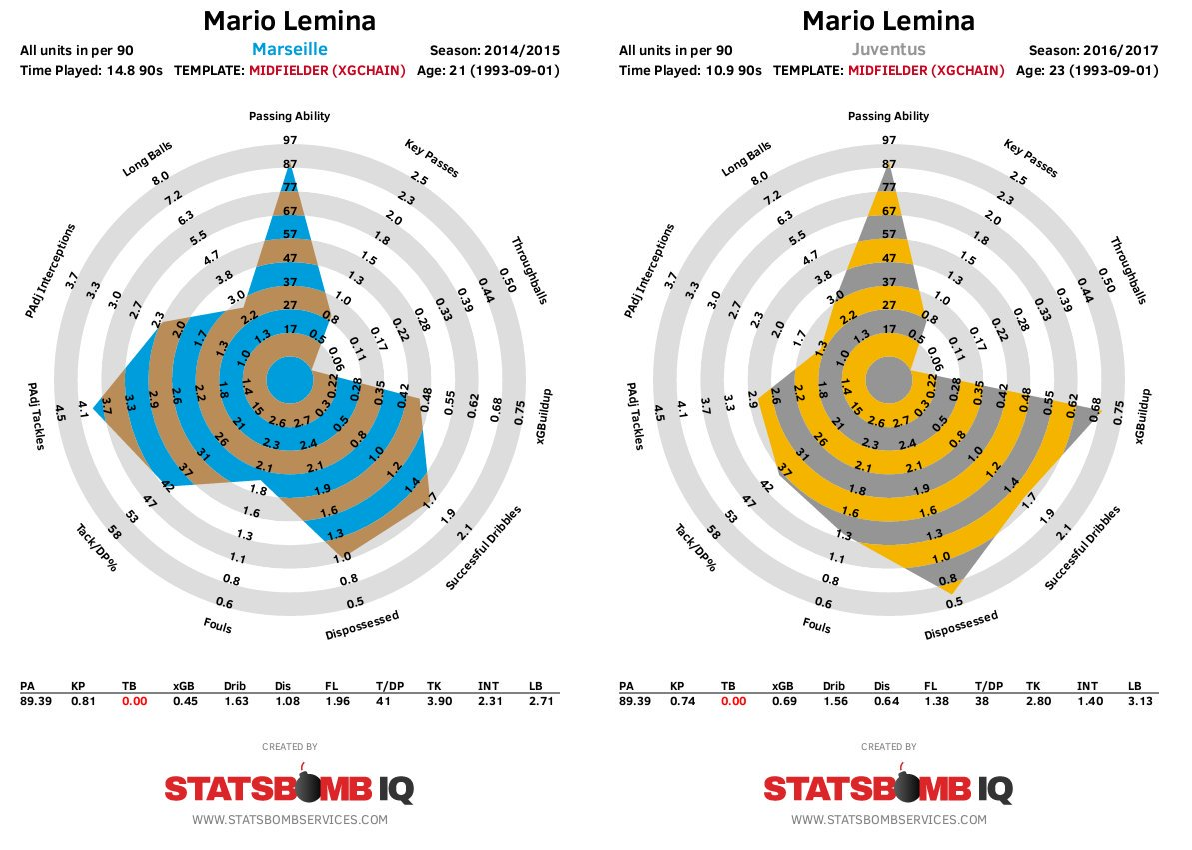 It is a bit odd that at age 23, Lemina hasn't played more than 1330 league minutes in a single season, but some of that can be explained: he was injured in the beginning of 14-15 and couldn't break into Marcelo Bielsa's starting XI at Marseille until November, and Juventus had a lot of players in the central midfield positions. You can find good value at times by just snapping up young players on mega clubs that don't get consistent playing time (see
It is a bit odd that at age 23, Lemina hasn't played more than 1330 league minutes in a single season, but some of that can be explained: he was injured in the beginning of 14-15 and couldn't break into Marcelo Bielsa's starting XI at Marseille until November, and Juventus had a lot of players in the central midfield positions. You can find good value at times by just snapping up young players on mega clubs that don't get consistent playing time (see 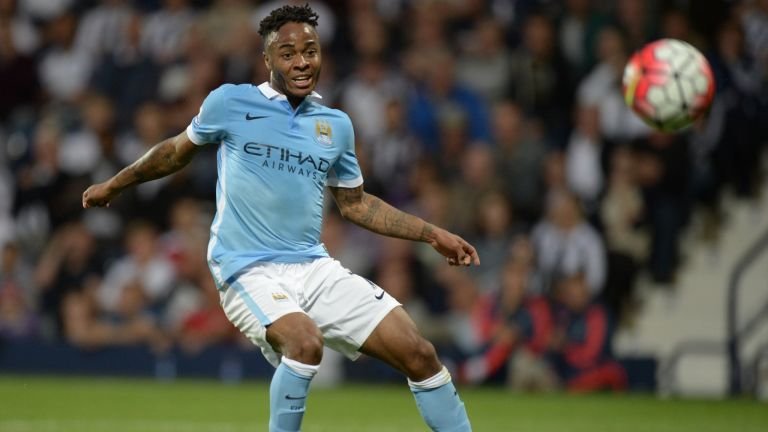
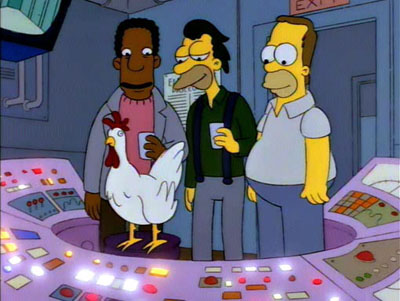
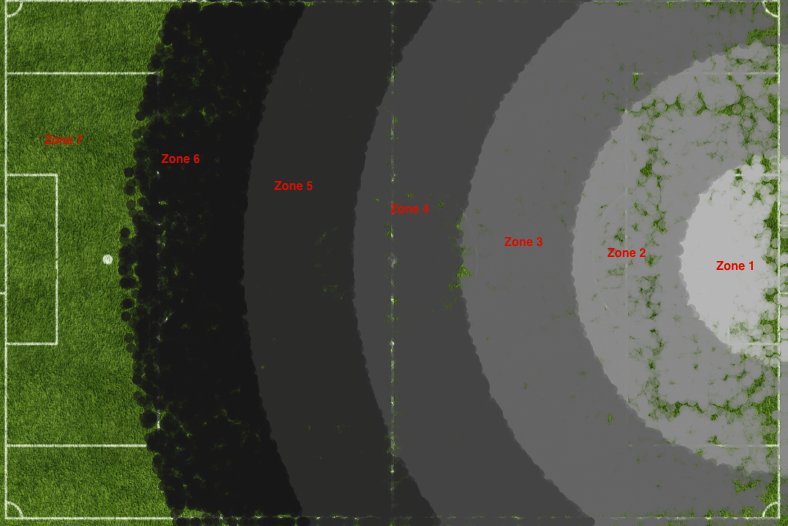 Keep this chart of the different zones handy, I will use it in each different question. Attacking left to right so zone 1 on the right is closest to goal, zone 7 is furthest on the left. 1. Can West Ham get the ball out of midfield?
Keep this chart of the different zones handy, I will use it in each different question. Attacking left to right so zone 1 on the right is closest to goal, zone 7 is furthest on the left. 1. Can West Ham get the ball out of midfield? 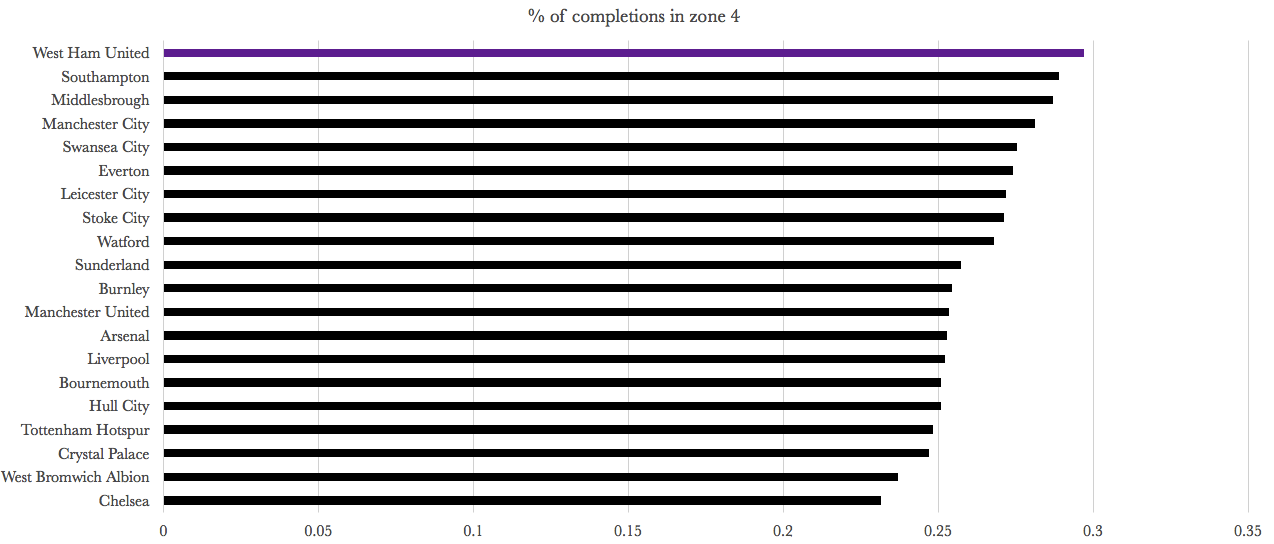
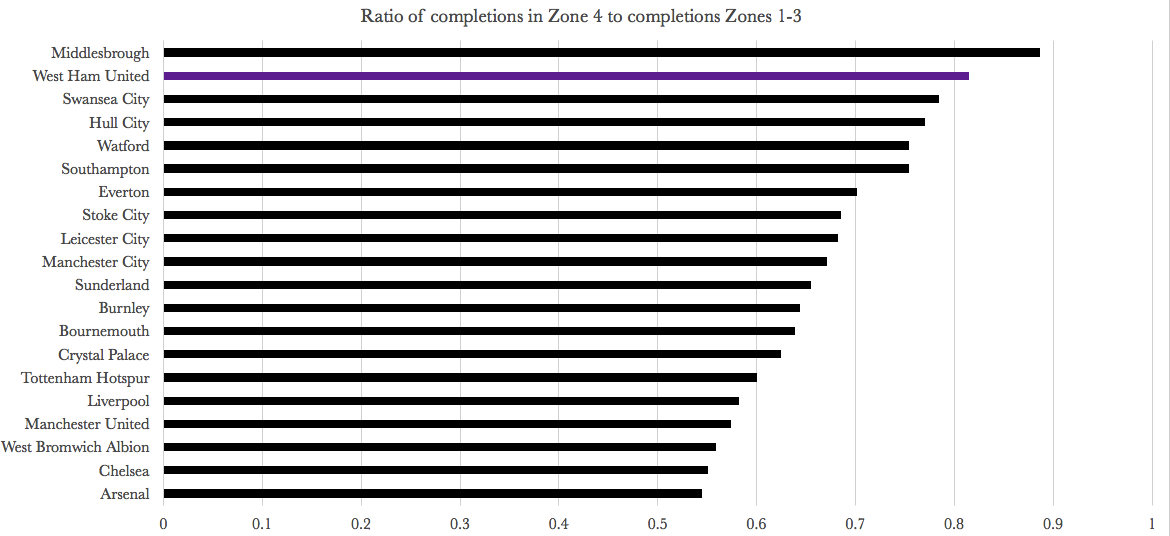 I'm forever playing passes Pretty passes in zone 4. They fly so high, Nearly reach the sky, Then like my dreams, They fade and die. No team in the league had a higher % of their completions coming in the “midfield” zone (4) about 45-60 yards from goal than West Ham. This isn’t a death knell for your attack (see Man City and Everton) but looking at the ratio of completions zone 4 to zones 1-3 (closer to goal) shows the stagnant attacks of Swansea, Hull, and Middlesborough alongside the Hammers. West Ham’s biggest problem is not that they do not complete the forward passes they attempt (mid-pack there), it’s that they simply do not attempt many forward passes from the midfield (31.3% of total passes from the zone go forward, second-fewest in the league). When we drill down to the individual players we find two high-volume passers who simply do not play the ball forward: Manuel Lanzini and Cheikhou Kouyate. They played the 2nd and 3rd most passes on the team from this zone and only passed it forward 24.3 and 22.1% of the time respectively. Among the other 19 teams in the PL, there is only one player who cracks their respective teams top 3 in volume coupled with a sub-25% forward rate: oddly enough it's Burnley's Jeff Hendrick. One Hammer passes back from the right, and one from the left, but both do it often.
I'm forever playing passes Pretty passes in zone 4. They fly so high, Nearly reach the sky, Then like my dreams, They fade and die. No team in the league had a higher % of their completions coming in the “midfield” zone (4) about 45-60 yards from goal than West Ham. This isn’t a death knell for your attack (see Man City and Everton) but looking at the ratio of completions zone 4 to zones 1-3 (closer to goal) shows the stagnant attacks of Swansea, Hull, and Middlesborough alongside the Hammers. West Ham’s biggest problem is not that they do not complete the forward passes they attempt (mid-pack there), it’s that they simply do not attempt many forward passes from the midfield (31.3% of total passes from the zone go forward, second-fewest in the league). When we drill down to the individual players we find two high-volume passers who simply do not play the ball forward: Manuel Lanzini and Cheikhou Kouyate. They played the 2nd and 3rd most passes on the team from this zone and only passed it forward 24.3 and 22.1% of the time respectively. Among the other 19 teams in the PL, there is only one player who cracks their respective teams top 3 in volume coupled with a sub-25% forward rate: oddly enough it's Burnley's Jeff Hendrick. One Hammer passes back from the right, and one from the left, but both do it often. 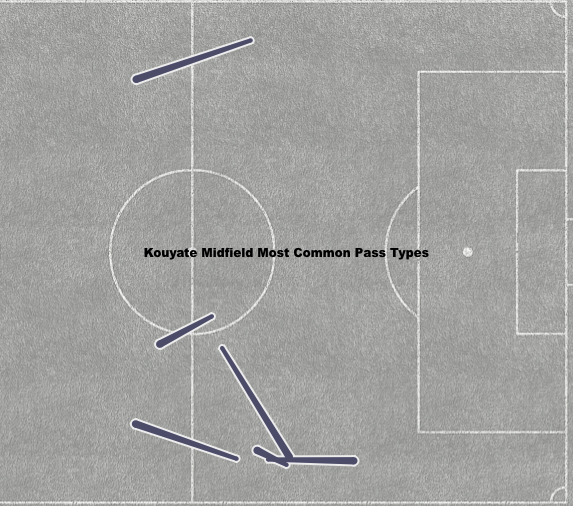
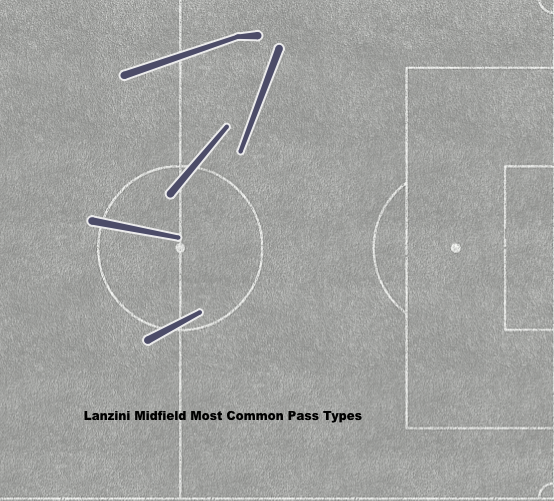 Pass types mean I grouped all PL passes into 100 different types (the start of t
Pass types mean I grouped all PL passes into 100 different types (the start of t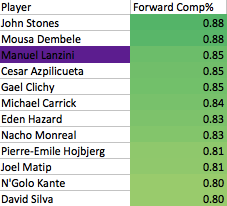 Very odd to see him there amongst the big boys when his team is having such problems moving the ball forward. I suspect Lanzini, while probably lacking options forward, is not being aggressive enough when the ball is played to him. West Ham analysts should be raising their eyebrows at this and trying to get answers from Lanzini and the coaching staff as to why he so often settles for playing the ball sideways or backwards instead of progressing the attack, which he's been one of the best in the league at. Encourage him to do it more, say a few more incompletions might not necessarily be a bad thing as we try to move out this midfield bog. Kouyate is a tougher problem as he showed neither the proclivity to pass forwards or much skill at doing so (league average comp% coming from a deep, deep-lying midfielder is poor). He just doesn't look like a good progressive passer of the ball and being aware of that and developing other ways of moving the ball forward needs to be a focus. Maybe Arnautovic can be a better receiver than say Antonio was, but this will remain an area to watch for West Ham fans in the early weeks of the season. 2. Can the league get the ball in front of Chelsea's goal? Chelsea allowed opponents to have the ball more than any of the other big 6, but were pretty Atletico-ish defending their goal (
Very odd to see him there amongst the big boys when his team is having such problems moving the ball forward. I suspect Lanzini, while probably lacking options forward, is not being aggressive enough when the ball is played to him. West Ham analysts should be raising their eyebrows at this and trying to get answers from Lanzini and the coaching staff as to why he so often settles for playing the ball sideways or backwards instead of progressing the attack, which he's been one of the best in the league at. Encourage him to do it more, say a few more incompletions might not necessarily be a bad thing as we try to move out this midfield bog. Kouyate is a tougher problem as he showed neither the proclivity to pass forwards or much skill at doing so (league average comp% coming from a deep, deep-lying midfielder is poor). He just doesn't look like a good progressive passer of the ball and being aware of that and developing other ways of moving the ball forward needs to be a focus. Maybe Arnautovic can be a better receiver than say Antonio was, but this will remain an area to watch for West Ham fans in the early weeks of the season. 2. Can the league get the ball in front of Chelsea's goal? Chelsea allowed opponents to have the ball more than any of the other big 6, but were pretty Atletico-ish defending their goal (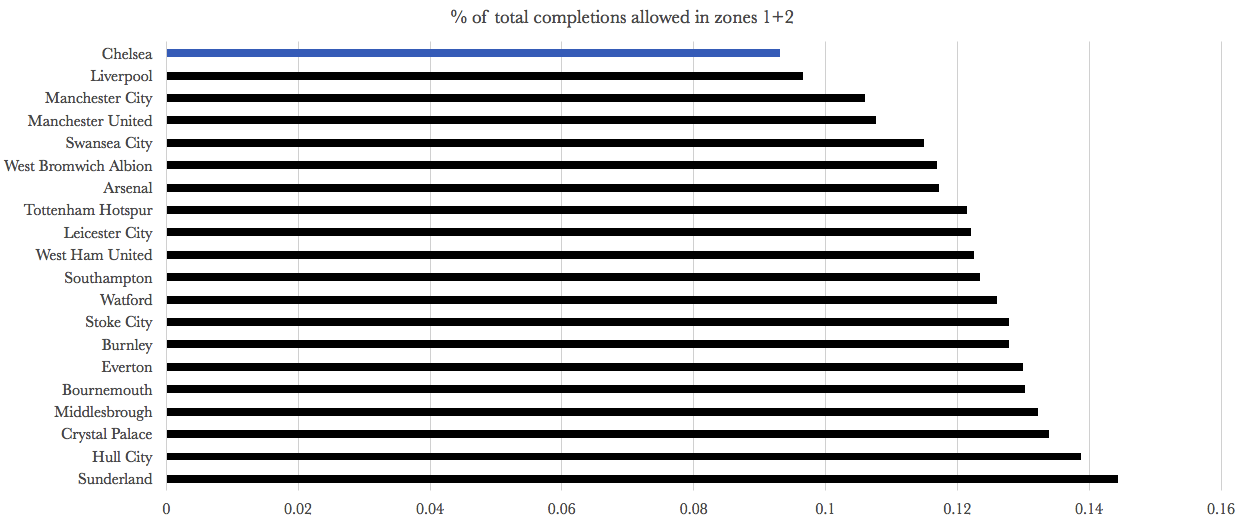
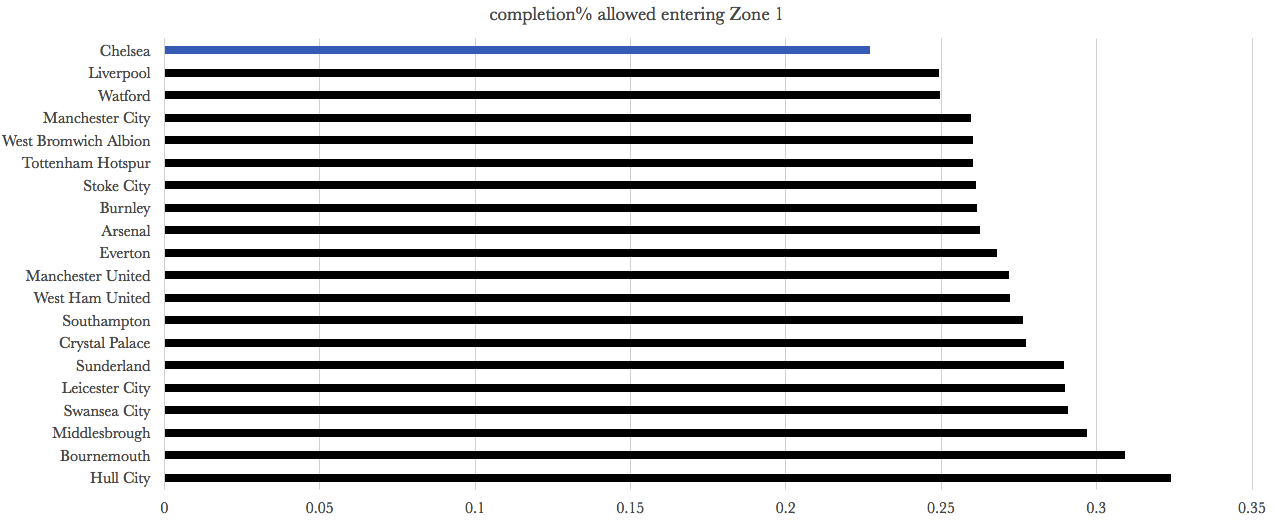 Chelsea do not press high consistently. Teams without renowned presses like Everton, Watford, Crystal Palace, and Arsenal all force opponents into a lower completion % high up the field. Chelsea's defensive set-up is clearly all about protecting that precious area in front of goal, when teams move the ball into the midfield they don't find it easy to go forward. This is the opposite of how many of the other elite defensive teams work (see City/Spurs below), where they harry you into rushing forward and look to win the ball back.
Chelsea do not press high consistently. Teams without renowned presses like Everton, Watford, Crystal Palace, and Arsenal all force opponents into a lower completion % high up the field. Chelsea's defensive set-up is clearly all about protecting that precious area in front of goal, when teams move the ball into the midfield they don't find it easy to go forward. This is the opposite of how many of the other elite defensive teams work (see City/Spurs below), where they harry you into rushing forward and look to win the ball back. 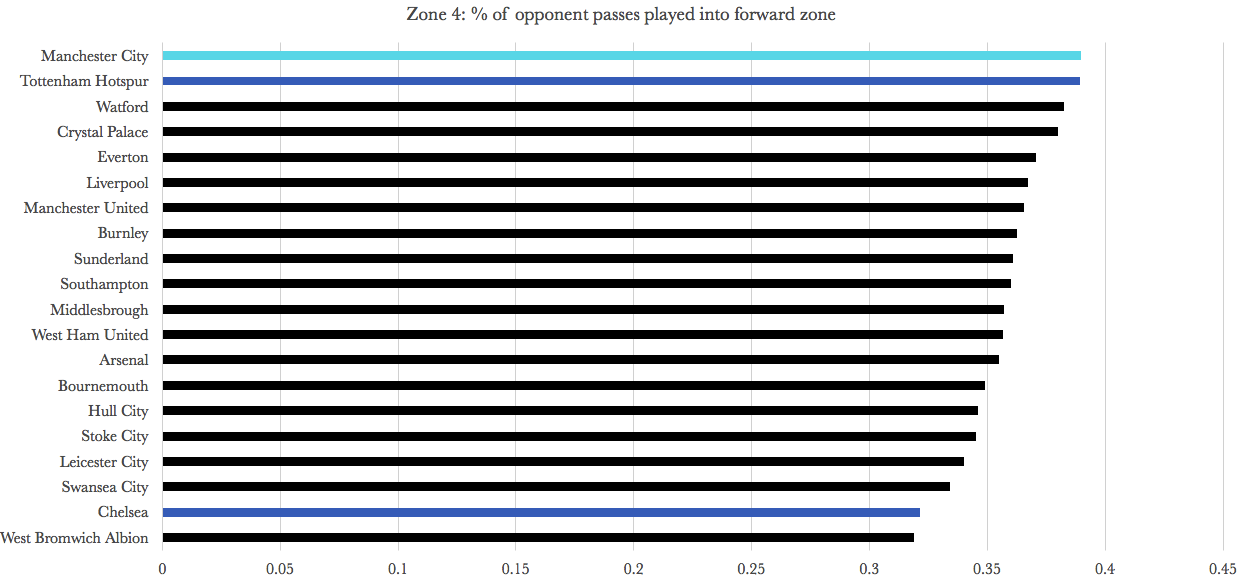 Once you get close to goal Chelsea do not allow you to set up quality shots with short key passes. They allowed 20% fewer sub-10 yard passes in zone 1 (15 yard radius around goal) than the team with the second fewest, Liverpool. Not much high-wire risk about the way Chelsea defend compared to say, Liverpool or Man City. Also, not much much reason to doubt their solidity continuing this year. You can make the case it could be improved with the addition of Bakayoko and Rudiger. However I'm not so sure that stiffening the team without the ball is the easiest way for them to improve shot prevention, right now the risk is probably not having the ball enough. A little less time without the ball might be an easier way of improvement. Aside from that debate, having this sturdy base provides a solid foundation for a title challenge, even if they aren't favorites to repeat. 3. Can Bournemouth's porous defense close up at the back and how good is Eddie Howe?
Once you get close to goal Chelsea do not allow you to set up quality shots with short key passes. They allowed 20% fewer sub-10 yard passes in zone 1 (15 yard radius around goal) than the team with the second fewest, Liverpool. Not much high-wire risk about the way Chelsea defend compared to say, Liverpool or Man City. Also, not much much reason to doubt their solidity continuing this year. You can make the case it could be improved with the addition of Bakayoko and Rudiger. However I'm not so sure that stiffening the team without the ball is the easiest way for them to improve shot prevention, right now the risk is probably not having the ball enough. A little less time without the ball might be an easier way of improvement. Aside from that debate, having this sturdy base provides a solid foundation for a title challenge, even if they aren't favorites to repeat. 3. Can Bournemouth's porous defense close up at the back and how good is Eddie Howe? 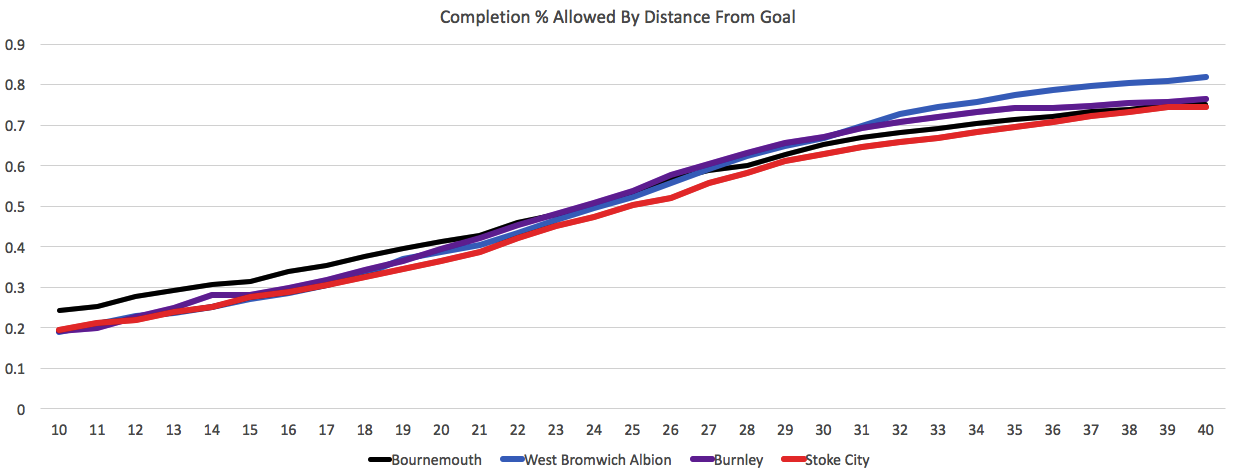 Cherries are not supposed to get softer the closer you get to the core. But look at the stark divergence between Bournemouth and three other lower-half teams as you get inside 20 yards. Two years ago they had a respectably fierce high press but last season that kind of withered away and you are left with this: a team that theoretically tries to press but really just leaves themselves open at the back. That is a recipe that lends itself to giving up 67 goals. That weakness was covered up a bit by a strong finish in the table equal on points with Saints. If Bournemouth want to repeat last year or improve, fixing this should be priority number one. This year will be a big test for Eddie Howe and will help clarify how good a manager he really is right now, there are data points and opinions all over the map on his first few years in the top flight. This year should help us hone in.
Cherries are not supposed to get softer the closer you get to the core. But look at the stark divergence between Bournemouth and three other lower-half teams as you get inside 20 yards. Two years ago they had a respectably fierce high press but last season that kind of withered away and you are left with this: a team that theoretically tries to press but really just leaves themselves open at the back. That is a recipe that lends itself to giving up 67 goals. That weakness was covered up a bit by a strong finish in the table equal on points with Saints. If Bournemouth want to repeat last year or improve, fixing this should be priority number one. This year will be a big test for Eddie Howe and will help clarify how good a manager he really is right now, there are data points and opinions all over the map on his first few years in the top flight. This year should help us hone in. 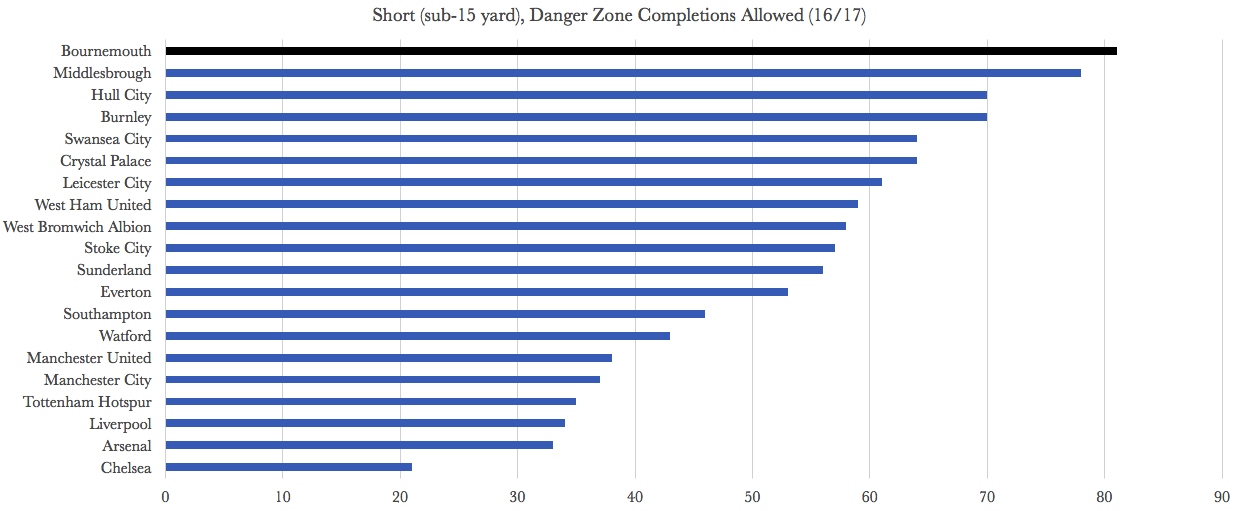 4. Will Burnley develop an alternative to their hit-and-hope build-up play? After Bournemouth, we come to their near-opposite in Sean Dyche's Burnley. Not only for their defensive divergence we saw above but for how they build up.
4. Will Burnley develop an alternative to their hit-and-hope build-up play? After Bournemouth, we come to their near-opposite in Sean Dyche's Burnley. Not only for their defensive divergence we saw above but for how they build up. 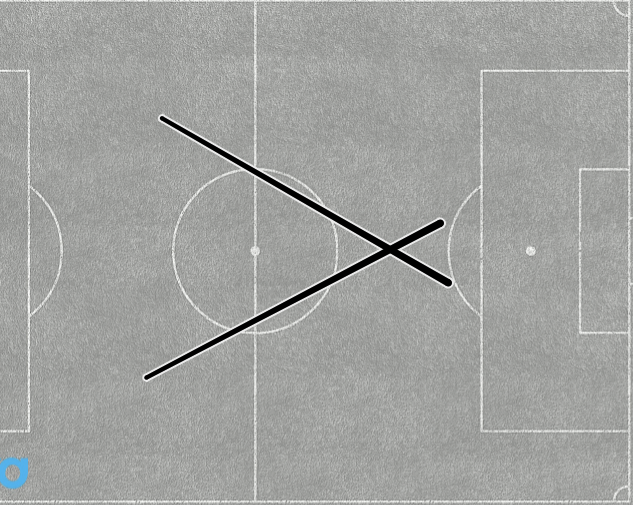
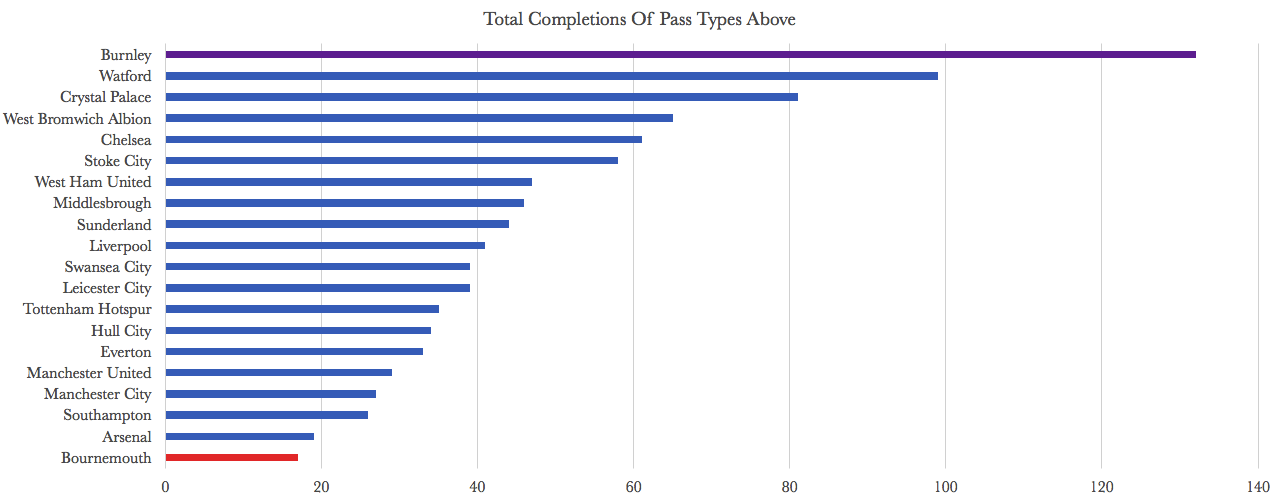
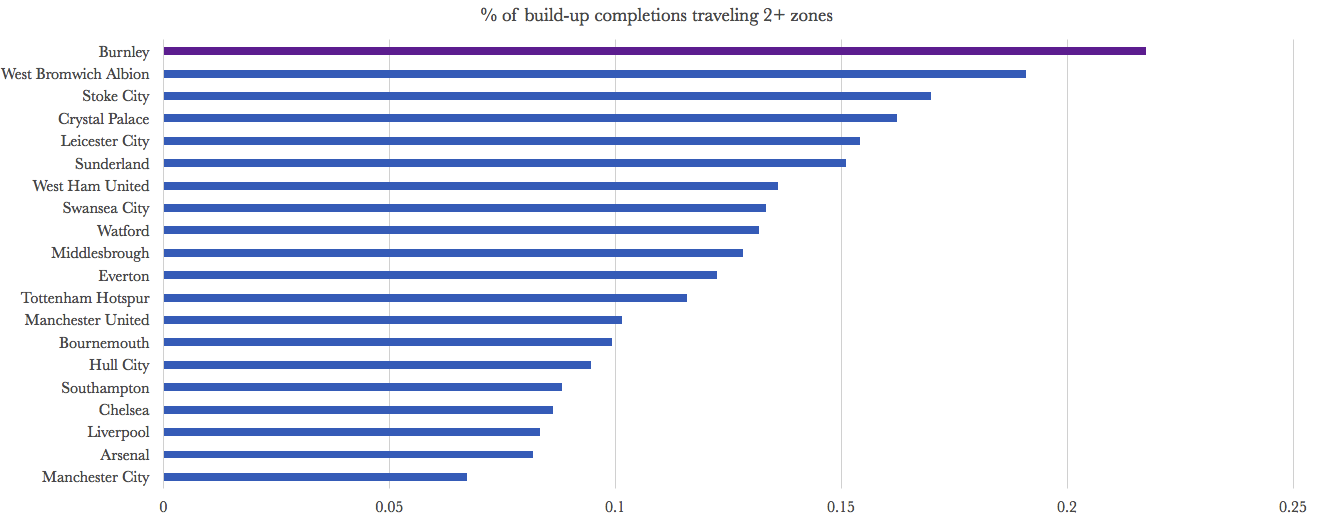 They stayed up deservedly through what was a distinctive long ball and shell in the box playing style but are one of the favorites to go down this season showing bookies are skeptical they can do it again. Burnley's best player %-wise at moving the ball forward from zones 5 and 4? Michael Keane, now an Everton player. New man Jack Cork presumably will be asked to be a progressive passer from midfield as Keane's loss will put more pressure on Burnley's midfielders to actually move the ball. Last year Marney and Hendrick would move the ball forward about as often as Sean Dyche made an appointment to get his hair styled.
They stayed up deservedly through what was a distinctive long ball and shell in the box playing style but are one of the favorites to go down this season showing bookies are skeptical they can do it again. Burnley's best player %-wise at moving the ball forward from zones 5 and 4? Michael Keane, now an Everton player. New man Jack Cork presumably will be asked to be a progressive passer from midfield as Keane's loss will put more pressure on Burnley's midfielders to actually move the ball. Last year Marney and Hendrick would move the ball forward about as often as Sean Dyche made an appointment to get his hair styled. 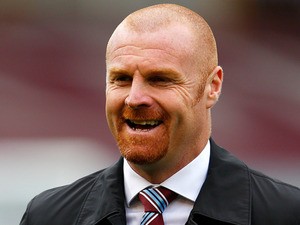 The numbers do not indicate Cork as Burnley's Iniesta. Cork was a quite hesitant player on Swansea and his percentages did not stand out at all relative to teammates (while they do compared to Burnley, the odds of that transferring are quite low).
The numbers do not indicate Cork as Burnley's Iniesta. Cork was a quite hesitant player on Swansea and his percentages did not stand out at all relative to teammates (while they do compared to Burnley, the odds of that transferring are quite low). 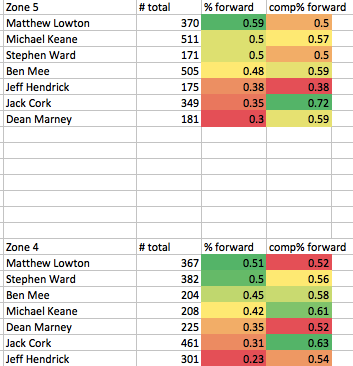 Burnley will likely remain a team that spends little time working through the middle and hopes they can pressure you with their defense and hit a few long balls over you to get shots. I suspect it won't work quite as well the second time through the league. And one more tip for Sean Dyche before we leave: go with the 3 on the sides, 5 up top next time, stop confusing the barbers with your elaborate requests. 5. Can City solve their strange in-box passing problem and become a super-powered attack?
Burnley will likely remain a team that spends little time working through the middle and hopes they can pressure you with their defense and hit a few long balls over you to get shots. I suspect it won't work quite as well the second time through the league. And one more tip for Sean Dyche before we leave: go with the 3 on the sides, 5 up top next time, stop confusing the barbers with your elaborate requests. 5. Can City solve their strange in-box passing problem and become a super-powered attack? 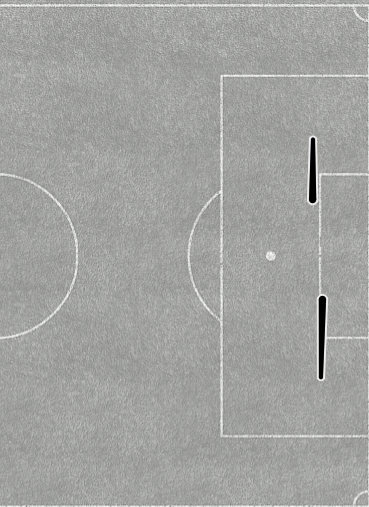
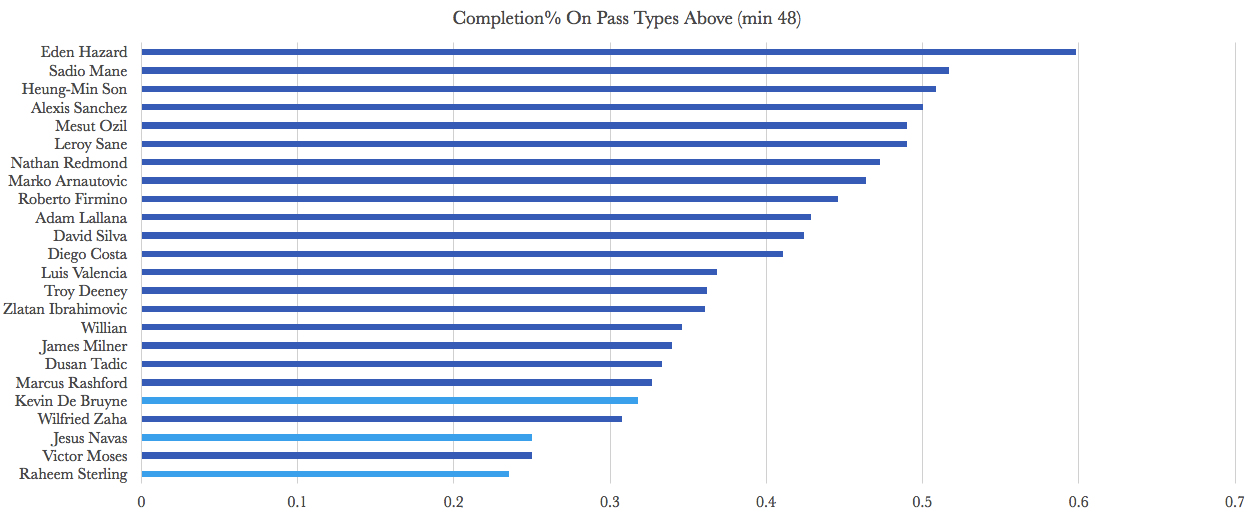 Why is one of the best play-makers in the league down sub-Milner on intra-box passes from the side? Yes, City probably face packed boxes but so does almost everyone on this list. De Bruyne and Sterling played 102 and 85 of these passes each, so it conceivably could be an oddity like the
Why is one of the best play-makers in the league down sub-Milner on intra-box passes from the side? Yes, City probably face packed boxes but so does almost everyone on this list. De Bruyne and Sterling played 102 and 85 of these passes each, so it conceivably could be an oddity like the 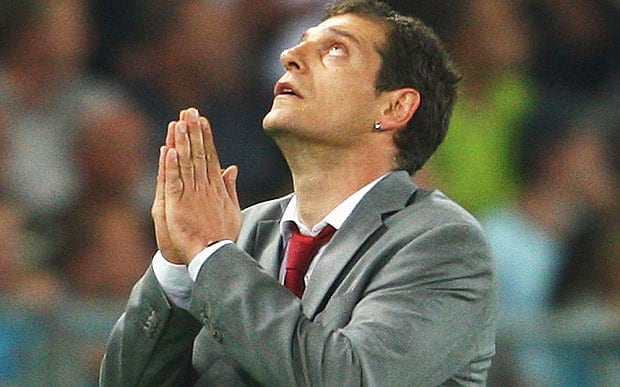
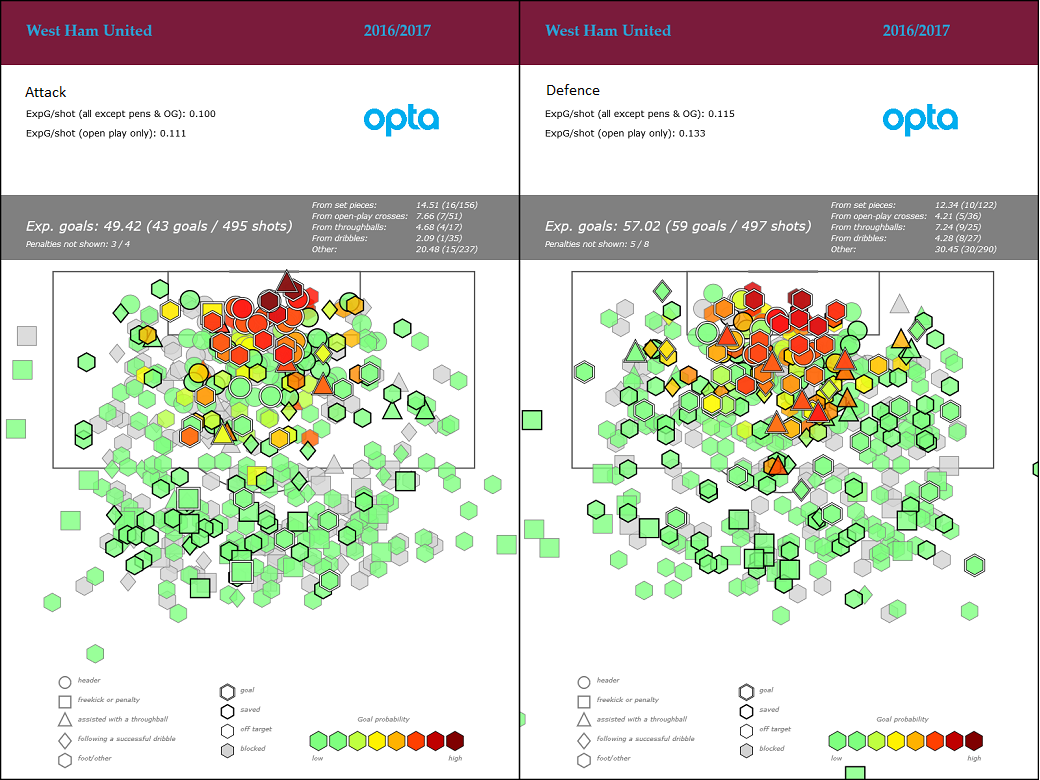 It isn’t unreasonable to think that West Ham could return to being what they were in 2015-16 but perhaps without the conversion luck they received. There’s enough credible attacking talent in the 27-29 age range, and perhaps enough of them to have prime caliber seasons at the same time. Andre Ayew quietly had a nice debut season, with a 0.56 NPGA per 90 rate in just 1411 minutes due to his early season injury. Another season of sub 65% save rate from their goalkeepers would be a problem though and the Olympic Stadium could end up as home to high amounts of entertaining 2-2/3-2 types of encounters. Transfers and Lack of Strategy West Ham transfer strategy is has been hard to fathom for quite some time now. You can look at some of the players they’ve been linked to over the past couple of summers and think that if this is what they were intending to do, they were on the right track: Alexandre Lacazette, Rachid Ghezzal, Kelechi Iheanacho, Michy Batshuayi. All those players at the respective prices they were listed at would’ve been fine value. They could even claim to have gotten one of the better value in the league over the past two or so years when they signed Dimitri Payet for around £11M in the summer of 2015, and he proceeded to have a very good, albeit short, tenure at the club before the messy divorce. Hell, even if you look at this summer’s moves in isolation, they’re not *that* bad. Javier Hernandez is a professional goal scorer who’s averaged 0.60 non-penalty goals per 90 over the past four seasons. He’s damn good at what he does, and West Ham fans are probably overjoyed at having an actual proper striker to lead the line considering who’s manned that position over the years. Meanwhile Marko Arnautovic on middling Stoke sides has been a consistent attacker. He’s was one of the few redeeming parts on what was a lost season for the club in 2016-17, and he’s arguably the best hope for replicating the kind of production that Payet brought to the club from that left sided position:
It isn’t unreasonable to think that West Ham could return to being what they were in 2015-16 but perhaps without the conversion luck they received. There’s enough credible attacking talent in the 27-29 age range, and perhaps enough of them to have prime caliber seasons at the same time. Andre Ayew quietly had a nice debut season, with a 0.56 NPGA per 90 rate in just 1411 minutes due to his early season injury. Another season of sub 65% save rate from their goalkeepers would be a problem though and the Olympic Stadium could end up as home to high amounts of entertaining 2-2/3-2 types of encounters. Transfers and Lack of Strategy West Ham transfer strategy is has been hard to fathom for quite some time now. You can look at some of the players they’ve been linked to over the past couple of summers and think that if this is what they were intending to do, they were on the right track: Alexandre Lacazette, Rachid Ghezzal, Kelechi Iheanacho, Michy Batshuayi. All those players at the respective prices they were listed at would’ve been fine value. They could even claim to have gotten one of the better value in the league over the past two or so years when they signed Dimitri Payet for around £11M in the summer of 2015, and he proceeded to have a very good, albeit short, tenure at the club before the messy divorce. Hell, even if you look at this summer’s moves in isolation, they’re not *that* bad. Javier Hernandez is a professional goal scorer who’s averaged 0.60 non-penalty goals per 90 over the past four seasons. He’s damn good at what he does, and West Ham fans are probably overjoyed at having an actual proper striker to lead the line considering who’s manned that position over the years. Meanwhile Marko Arnautovic on middling Stoke sides has been a consistent attacker. He’s was one of the few redeeming parts on what was a lost season for the club in 2016-17, and he’s arguably the best hope for replicating the kind of production that Payet brought to the club from that left sided position: 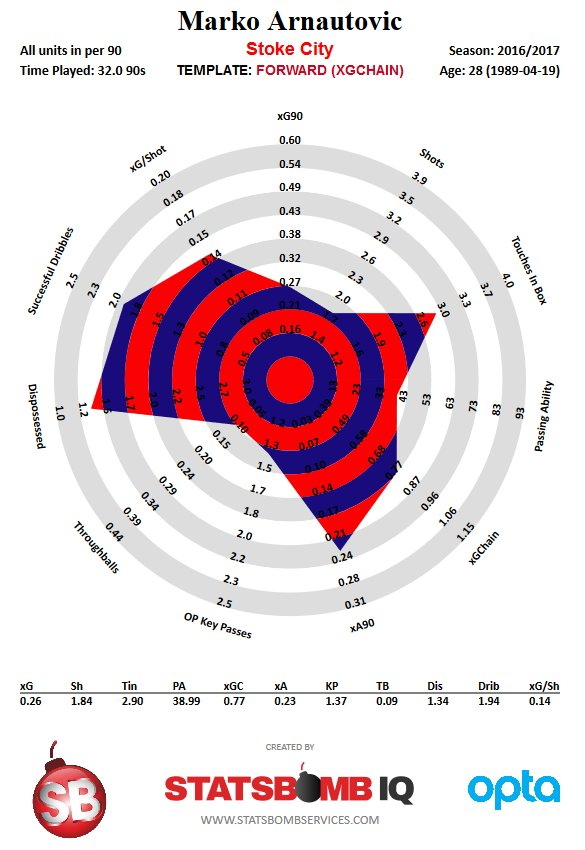 That’s probably where the positivity ends. Joe Hart has been in decline over time and beyond not being a stylistic fit at Man City, his year in Italy was erratic at best. Thankfully he’s only on a one year loan, but it looks like Adrian has got a rough deal as he has been one of the best
That’s probably where the positivity ends. Joe Hart has been in decline over time and beyond not being a stylistic fit at Man City, his year in Italy was erratic at best. Thankfully he’s only on a one year loan, but it looks like Adrian has got a rough deal as he has been one of the best 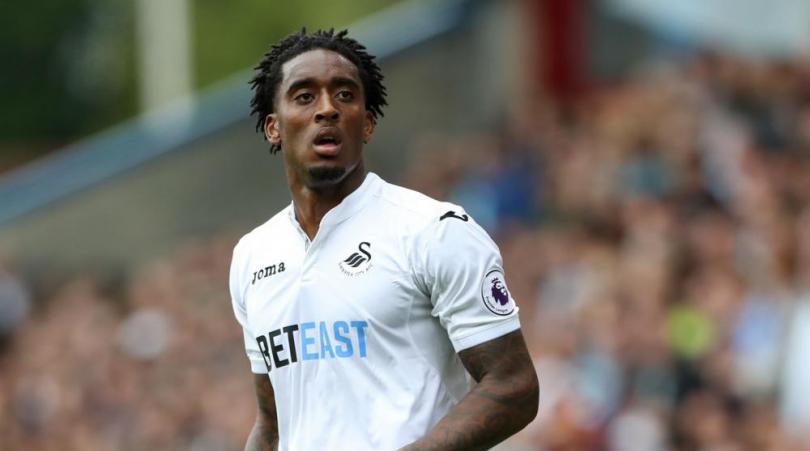
 What can we make of Swansea City’s year of scattershot manager hires? The club traded in Francesco Guidolin, a defense-first manager who struggled under a difficult schedule, for Bradley’s reckless attacking swagger. When Bradley proved disastrous, the club traded in for Clement, a manager with limited head coaching experience who shifted the focus back to defense. There appears to be no effort to maintain continuity in tactical systems or style of play. Whereas the club was once heralded for playing a technical passing style, that approach has
What can we make of Swansea City’s year of scattershot manager hires? The club traded in Francesco Guidolin, a defense-first manager who struggled under a difficult schedule, for Bradley’s reckless attacking swagger. When Bradley proved disastrous, the club traded in for Clement, a manager with limited head coaching experience who shifted the focus back to defense. There appears to be no effort to maintain continuity in tactical systems or style of play. Whereas the club was once heralded for playing a technical passing style, that approach has 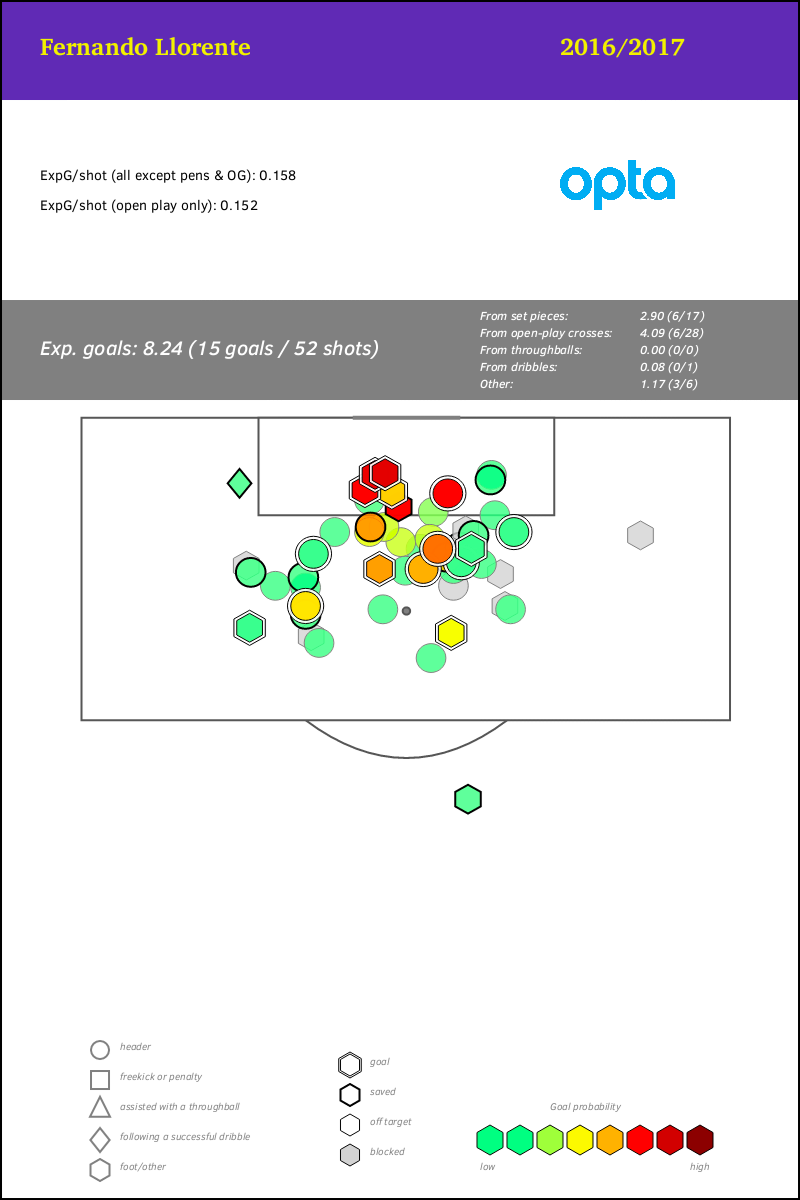 The club’s reliance on Llorente’s and Sigurdsson’s set piece act was necessary due to Swansea’s lack of creativity in open play. The team’s key pass leader in 2016-17 was Modou Barrow, who is now plying his trade in the Championship with Reading. Swansea’s next most common creator was an aging Wayne Routledge, while in 5th was Borja Bastón who mainly played substitute minutes. Arguably, the mercurial Jefferson Montero remains the best creator in the squad, though injuries and managerial disfavour means he rarely earns a starting place. Lack of chance creation seems the most obvious flaw Swansea need to address, and recruitment should prioritize targets accordingly.
The club’s reliance on Llorente’s and Sigurdsson’s set piece act was necessary due to Swansea’s lack of creativity in open play. The team’s key pass leader in 2016-17 was Modou Barrow, who is now plying his trade in the Championship with Reading. Swansea’s next most common creator was an aging Wayne Routledge, while in 5th was Borja Bastón who mainly played substitute minutes. Arguably, the mercurial Jefferson Montero remains the best creator in the squad, though injuries and managerial disfavour means he rarely earns a starting place. Lack of chance creation seems the most obvious flaw Swansea need to address, and recruitment should prioritize targets accordingly.  As is often the case, Swansea’s defense proves more difficult to evaluate than the attack. The task is made no easier given the back line’s relative success (or lack of) under various tactical systems last term. Paul Clement stemmed the tide of goals conceded after the Bradley experiment, but he did so by tightening the defense at the expense of attack. Questions remain about whether the personnel are good enough for Clement to loosen the tactics and allow more players to contribute going forward. Martin Olsson at left back seems a decent, if underwhelming replacement for Neil Taylor, who has looked out of his depth in the PL since a serious knee injury. Meanwhile, young Alfie Mawson has established his place in central defense, and played well under Clement’s system. The Cult of the New Who have Swansea recruited to address their issues in attack and chance creation? The club achieved something of a coup in securing Chelsea loanee Tammy Abraham. Not even 20 years old and already a ball of kinetic pace, guile and poacher’s instinct, with height and a strong build to match. Abraham absolutely crushed his debut season of professional football, netting 26 goals for a lackluster Bristol City side. With the potential to be a genuinely exciting player, the England U21 international could become the goal threat that Sigurdsson wasn’t, though he won’t fix the team’s issues with chance creation. Abraham remains young and has no substantive experience in a top league, and represents something of a gamble on that front. However, he is a low-cost signing with a high potential upside if he continues his form from last year.
As is often the case, Swansea’s defense proves more difficult to evaluate than the attack. The task is made no easier given the back line’s relative success (or lack of) under various tactical systems last term. Paul Clement stemmed the tide of goals conceded after the Bradley experiment, but he did so by tightening the defense at the expense of attack. Questions remain about whether the personnel are good enough for Clement to loosen the tactics and allow more players to contribute going forward. Martin Olsson at left back seems a decent, if underwhelming replacement for Neil Taylor, who has looked out of his depth in the PL since a serious knee injury. Meanwhile, young Alfie Mawson has established his place in central defense, and played well under Clement’s system. The Cult of the New Who have Swansea recruited to address their issues in attack and chance creation? The club achieved something of a coup in securing Chelsea loanee Tammy Abraham. Not even 20 years old and already a ball of kinetic pace, guile and poacher’s instinct, with height and a strong build to match. Abraham absolutely crushed his debut season of professional football, netting 26 goals for a lackluster Bristol City side. With the potential to be a genuinely exciting player, the England U21 international could become the goal threat that Sigurdsson wasn’t, though he won’t fix the team’s issues with chance creation. Abraham remains young and has no substantive experience in a top league, and represents something of a gamble on that front. However, he is a low-cost signing with a high potential upside if he continues his form from last year. 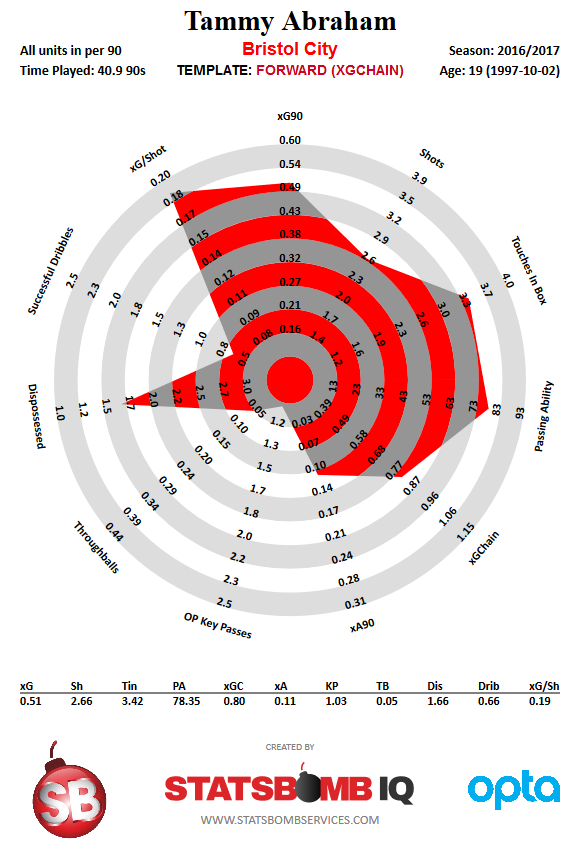 Swansea’s other notable signing, this time a permanent transfer, is Roque Mesa. The midfielder has spent most of his career in the lower divisions of Spain, but has played an important role in Las Palmas’ two most recent campaigns in La Liga. A very strong passer who is good on the ball, Mesa seems the spiritual successor to Leon Britton, who has long been the metronome at the base of the Swansea midfield. Though the Spaniard is 28, he fills some of the creative void in midfield and should hold down a regular starting place this season.
Swansea’s other notable signing, this time a permanent transfer, is Roque Mesa. The midfielder has spent most of his career in the lower divisions of Spain, but has played an important role in Las Palmas’ two most recent campaigns in La Liga. A very strong passer who is good on the ball, Mesa seems the spiritual successor to Leon Britton, who has long been the metronome at the base of the Swansea midfield. Though the Spaniard is 28, he fills some of the creative void in midfield and should hold down a regular starting place this season. 
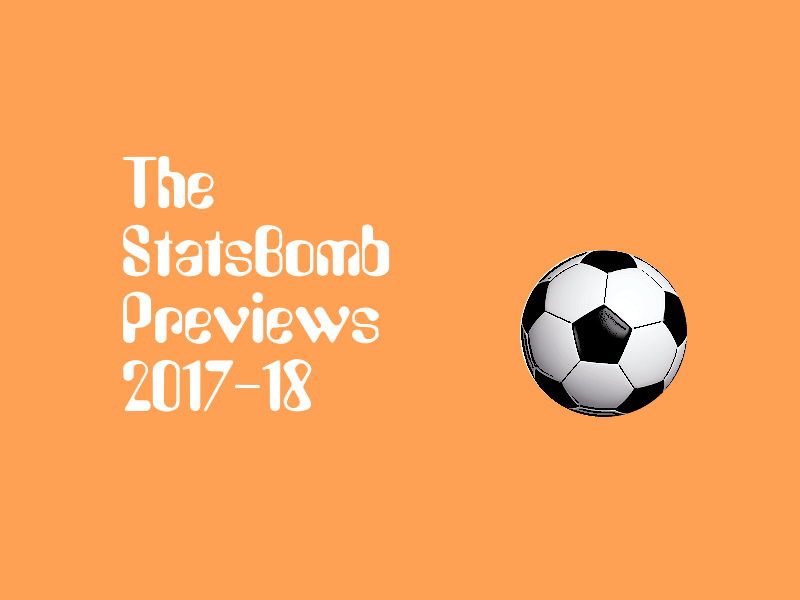
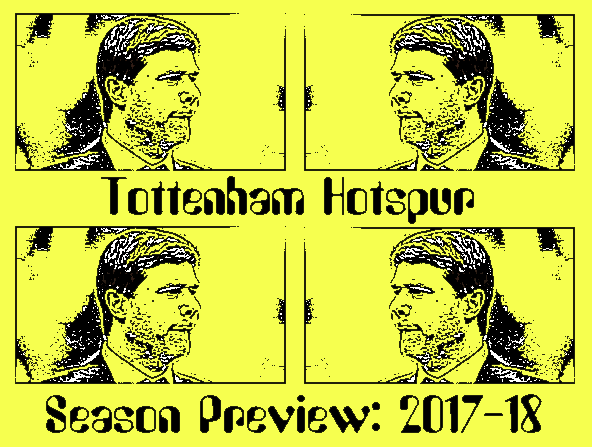
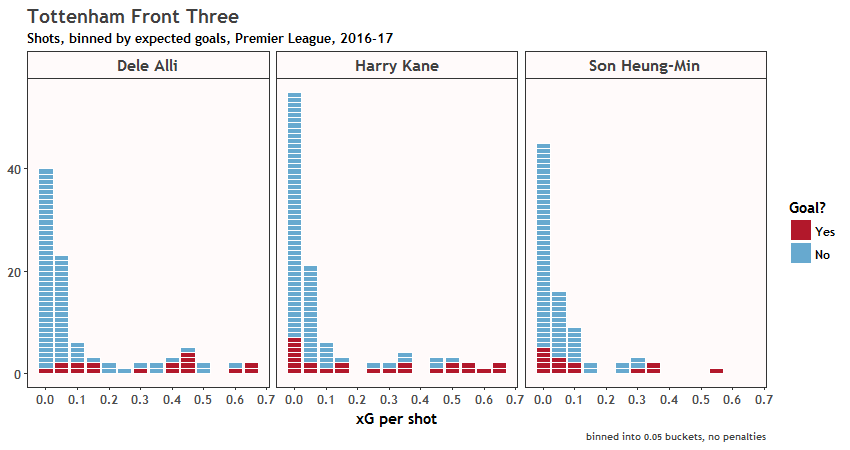 All three of Tottenham’s main goalscorers scored both freely and ahead of expectation last season, but there is some evidence to imply that it's recurrent enough to include some signal. Kane has been ahead in all his three full seasons of play albeit by varying degrees (2016-17 by far the heaviest overshoot), Alli in both his and Son has a strong long term finishing record too. For Son, as the chart shows, he doesn’t get many high value chances, but continues to rack up the goals. Of course goals don’t make themselves, so ticking away behind this deadly trio was the ever under heralded Christian Eriksen. Quietly, the most dangerous open play combination was Eriksen to Alli, but if we look at how Eriksen creates chances for his attackers we can see Tottenham’s attacking gameplan in front of us; indeed that’s exactly it: Tottenham play a system that pushes defences back. They rarely draw teams out to create space behind and instead tend to squeeze the play:
All three of Tottenham’s main goalscorers scored both freely and ahead of expectation last season, but there is some evidence to imply that it's recurrent enough to include some signal. Kane has been ahead in all his three full seasons of play albeit by varying degrees (2016-17 by far the heaviest overshoot), Alli in both his and Son has a strong long term finishing record too. For Son, as the chart shows, he doesn’t get many high value chances, but continues to rack up the goals. Of course goals don’t make themselves, so ticking away behind this deadly trio was the ever under heralded Christian Eriksen. Quietly, the most dangerous open play combination was Eriksen to Alli, but if we look at how Eriksen creates chances for his attackers we can see Tottenham’s attacking gameplan in front of us; indeed that’s exactly it: Tottenham play a system that pushes defences back. They rarely draw teams out to create space behind and instead tend to squeeze the play: 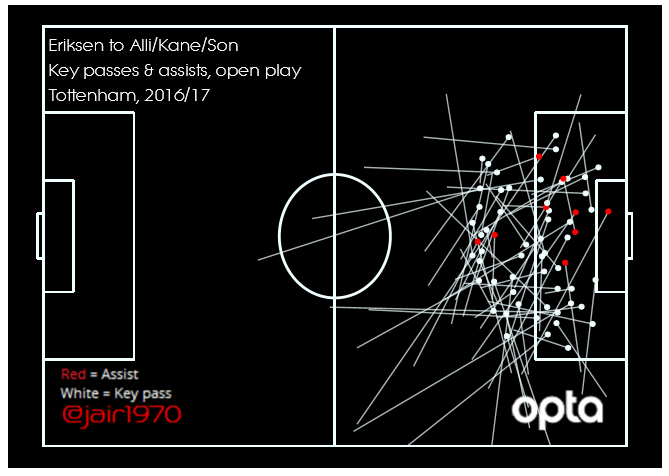 Two passes that Eriksen creates for Tottenham’s shots are sideways for long range efforts or vertical but not deep. Indeed, Tottenham do not create a lot of deep chances outside of set pieces and this undoubtedly impacts on their expected numbers. This retained strategy has had improved success year on year against weaker outfits, but does not always work as erratic displays in Europe and against some of their peers demonstrate. Tottenham can be unplayable on their day--witness the utter hammering of Arsenal at White Hart Lane--but equally find a good team that knows how to press and they can be quickly undone. Liverpool under Klopp and Man City have caused Pochettino’s men severe problems on more than one occasion. The major challenge for the side is to work out a method of nullifying the opposition in these type of games. They look to be drilled well enough to continue to overrun teams, but to make the next step they need to find extra from somewhere. Whether Pochettino has the flexibility to recognise this is hard to know but prior to 2016-17, nobody thought that he would veer away from his stock 4-2-3-1 but he did, and the way that Son and Alli joined Kane in attack so regularly certainly challenged the orthodoxy of the attacking midfield and forwards roles in his system. Transfers This time last year, Tottenham had already made two signings of the in Victor Wanyama and Vincent Janssen. Others followed later on--to lesser degrees of success than the Kenyan, about par with the Dutchman--but it was probably the first summer in memory that Tottenham faced a transfer window without an essential need to improve the first team. That Wanyama did was a bonus, and his recruitment explained Mauricio Pochettino’s surprise repositioning of Eric Dier into defensive midfield the season prior. That experiment went so well that Dier became England’s defensive midfield lynchpin too, but not so well that any idea that he was going to be placed there long term for Tottenham dissolved once Wanyama arrived. A similar situation faces the club now. The first eleven when fit pretty much picks itself and there’s probably enough depth to allocate anywhere around 15 or 16 of the first team squad as genuine first teamers and options, with perhaps less need than a nervous fan base might think to make big adjustments. That said, no team can rest on its laurels with regard to recruitment and there are areas that could be improved or given better depth. Decisions that look like they could be made include: *Ross Barkley *Kyle Walker replacement *More Mousa Dembélés *alt-Kane *Someone of the imagined calibre of Moussa Sissoko *Someone for the “promising ex-Ligue 1 winger/forward who won’t get in the team” role most recently inhabited by Clinton N’Jie and Georges Kevin N’Koudou *A mythical Mousa Dembélé / Christian Eriksen hybrid, like... say... er… did I mention Ross Barkley? One thing that seems certain: Tottenham are not going to spend a fortune. Kyle Walker’s departure has stuffed the hamper for a summer fund, while bits picked up for a departing Federico Fazio and N’Jie should help too. Hell, Nabil Bentaleb brought in £16million at some point since the last bit of money was spent. However, it’s now August, the pre-season is complete and all we are seeing are light promises that the club will buy. Nothing concrete and a nearly neutered and silent rumour mill. If the first team is not easily improved and certainly not within the wage structure, then that shouldn’t stop the club stuffing the bench with coin flip potential stars aged 18-23 years old. Wages can be afforded for promising talent and for a club that acquired and developed variously a 23 year old Luka Modrić, Gareth Bale as a teenager and much of the current first team from near birth, a reticence to go again is so far disappointing. On the other hand, that only Kyle Walker has departed from the first team feels like a necessary but best case and small exodus. Pochettino has said they will buy, so presumably they will. Identities remain unknown, but Ross Barkley continues to play wall ball against the side of his garage waiting for his phone to vibrate. Future Last season it was simple to presume that Tottenham would do little more than maintain, and instead they bounced forward. This season it is again straightforward enough to presume that they will maintain, but more towards the level that some of their structural metrics suggested rather than a dreamy land of 80+ points. Expected goals and bookies like them more or less the same as a year ago and think the 70-71 point baseline we have seen so frequently remains their true level. The Wembley factor looms and will no doubt be cited as the reason for any normal reversion but with a non-zero possibility that Pochettino’s systems do create some kind of positive skew against expected goal models it feels most likely that they will end up on seventy-something points. Should this transpire, and regardless of what position it lands the team in, it should not be considered disappointing. The whole club philosophy is to become a Champions League side in time for the new stadium, and so far the team’s performance is two years ahead of plan. But the whole game is also a balancing act. If Kyle Walker picks up a trophy this year, how many players will look on with envy? The best way for Tottenham to keep the band together is to win something themselves. It will not be easy, but it feels like the Pochettino era needs something tangible to represent the undeniable progress towards stability. The year before Pochettino arrived, in which Andre Villas Boas and Tim Sherwood competed to out-backend of a pantomime horse each other, only one outfield player played three-quarters of Tottenham’s league minutes. In year one, 2014-15, as Pochettino found out about the players he had that number crept up to four. In the last two seasons Tottenham have had eight outfielders play that frequently. The team picks itself, but can it make the next step? It could be vital that they do. ___________________________________
Two passes that Eriksen creates for Tottenham’s shots are sideways for long range efforts or vertical but not deep. Indeed, Tottenham do not create a lot of deep chances outside of set pieces and this undoubtedly impacts on their expected numbers. This retained strategy has had improved success year on year against weaker outfits, but does not always work as erratic displays in Europe and against some of their peers demonstrate. Tottenham can be unplayable on their day--witness the utter hammering of Arsenal at White Hart Lane--but equally find a good team that knows how to press and they can be quickly undone. Liverpool under Klopp and Man City have caused Pochettino’s men severe problems on more than one occasion. The major challenge for the side is to work out a method of nullifying the opposition in these type of games. They look to be drilled well enough to continue to overrun teams, but to make the next step they need to find extra from somewhere. Whether Pochettino has the flexibility to recognise this is hard to know but prior to 2016-17, nobody thought that he would veer away from his stock 4-2-3-1 but he did, and the way that Son and Alli joined Kane in attack so regularly certainly challenged the orthodoxy of the attacking midfield and forwards roles in his system. Transfers This time last year, Tottenham had already made two signings of the in Victor Wanyama and Vincent Janssen. Others followed later on--to lesser degrees of success than the Kenyan, about par with the Dutchman--but it was probably the first summer in memory that Tottenham faced a transfer window without an essential need to improve the first team. That Wanyama did was a bonus, and his recruitment explained Mauricio Pochettino’s surprise repositioning of Eric Dier into defensive midfield the season prior. That experiment went so well that Dier became England’s defensive midfield lynchpin too, but not so well that any idea that he was going to be placed there long term for Tottenham dissolved once Wanyama arrived. A similar situation faces the club now. The first eleven when fit pretty much picks itself and there’s probably enough depth to allocate anywhere around 15 or 16 of the first team squad as genuine first teamers and options, with perhaps less need than a nervous fan base might think to make big adjustments. That said, no team can rest on its laurels with regard to recruitment and there are areas that could be improved or given better depth. Decisions that look like they could be made include: *Ross Barkley *Kyle Walker replacement *More Mousa Dembélés *alt-Kane *Someone of the imagined calibre of Moussa Sissoko *Someone for the “promising ex-Ligue 1 winger/forward who won’t get in the team” role most recently inhabited by Clinton N’Jie and Georges Kevin N’Koudou *A mythical Mousa Dembélé / Christian Eriksen hybrid, like... say... er… did I mention Ross Barkley? One thing that seems certain: Tottenham are not going to spend a fortune. Kyle Walker’s departure has stuffed the hamper for a summer fund, while bits picked up for a departing Federico Fazio and N’Jie should help too. Hell, Nabil Bentaleb brought in £16million at some point since the last bit of money was spent. However, it’s now August, the pre-season is complete and all we are seeing are light promises that the club will buy. Nothing concrete and a nearly neutered and silent rumour mill. If the first team is not easily improved and certainly not within the wage structure, then that shouldn’t stop the club stuffing the bench with coin flip potential stars aged 18-23 years old. Wages can be afforded for promising talent and for a club that acquired and developed variously a 23 year old Luka Modrić, Gareth Bale as a teenager and much of the current first team from near birth, a reticence to go again is so far disappointing. On the other hand, that only Kyle Walker has departed from the first team feels like a necessary but best case and small exodus. Pochettino has said they will buy, so presumably they will. Identities remain unknown, but Ross Barkley continues to play wall ball against the side of his garage waiting for his phone to vibrate. Future Last season it was simple to presume that Tottenham would do little more than maintain, and instead they bounced forward. This season it is again straightforward enough to presume that they will maintain, but more towards the level that some of their structural metrics suggested rather than a dreamy land of 80+ points. Expected goals and bookies like them more or less the same as a year ago and think the 70-71 point baseline we have seen so frequently remains their true level. The Wembley factor looms and will no doubt be cited as the reason for any normal reversion but with a non-zero possibility that Pochettino’s systems do create some kind of positive skew against expected goal models it feels most likely that they will end up on seventy-something points. Should this transpire, and regardless of what position it lands the team in, it should not be considered disappointing. The whole club philosophy is to become a Champions League side in time for the new stadium, and so far the team’s performance is two years ahead of plan. But the whole game is also a balancing act. If Kyle Walker picks up a trophy this year, how many players will look on with envy? The best way for Tottenham to keep the band together is to win something themselves. It will not be easy, but it feels like the Pochettino era needs something tangible to represent the undeniable progress towards stability. The year before Pochettino arrived, in which Andre Villas Boas and Tim Sherwood competed to out-backend of a pantomime horse each other, only one outfield player played three-quarters of Tottenham’s league minutes. In year one, 2014-15, as Pochettino found out about the players he had that number crept up to four. In the last two seasons Tottenham have had eight outfielders play that frequently. The team picks itself, but can it make the next step? It could be vital that they do. ___________________________________ 